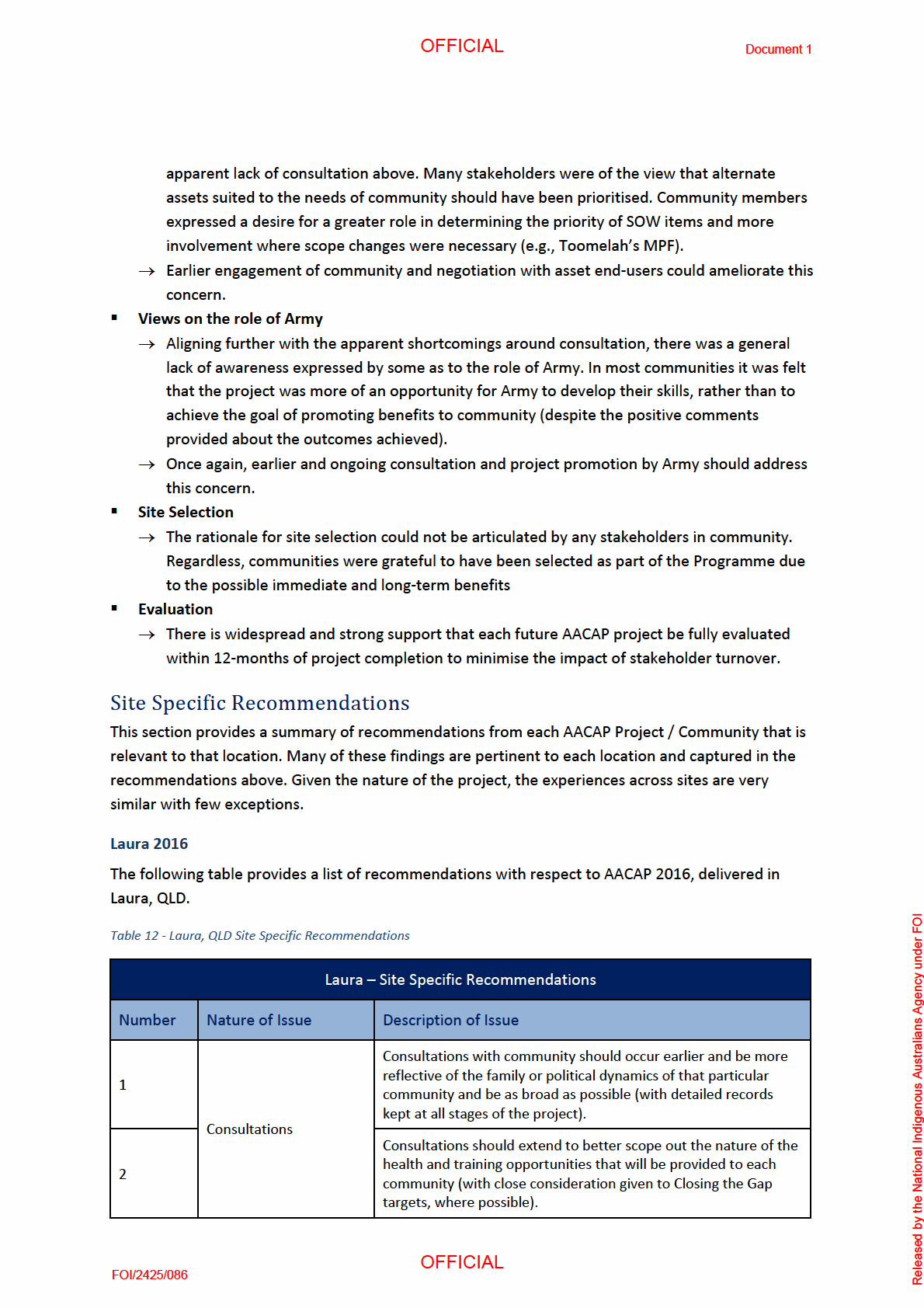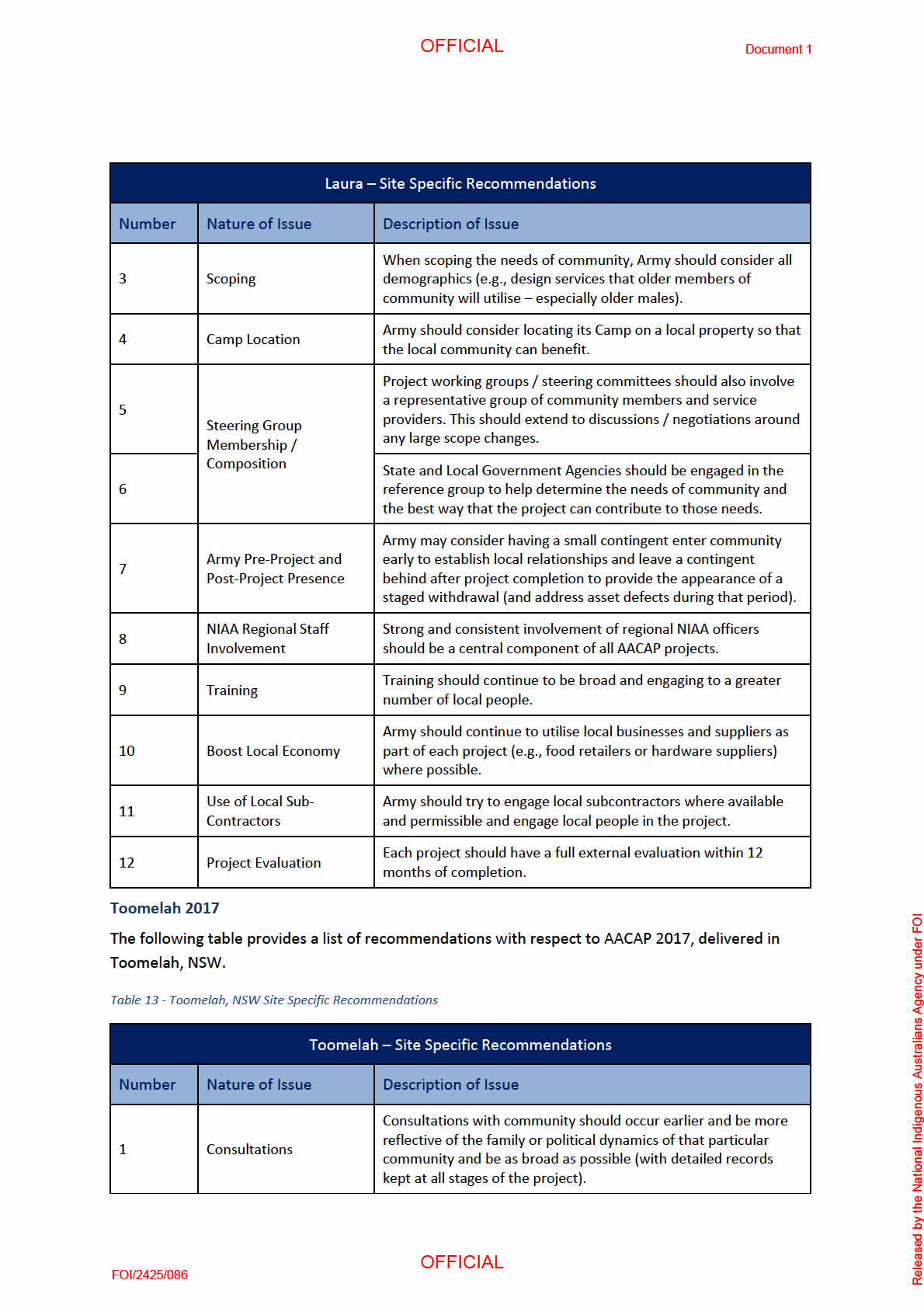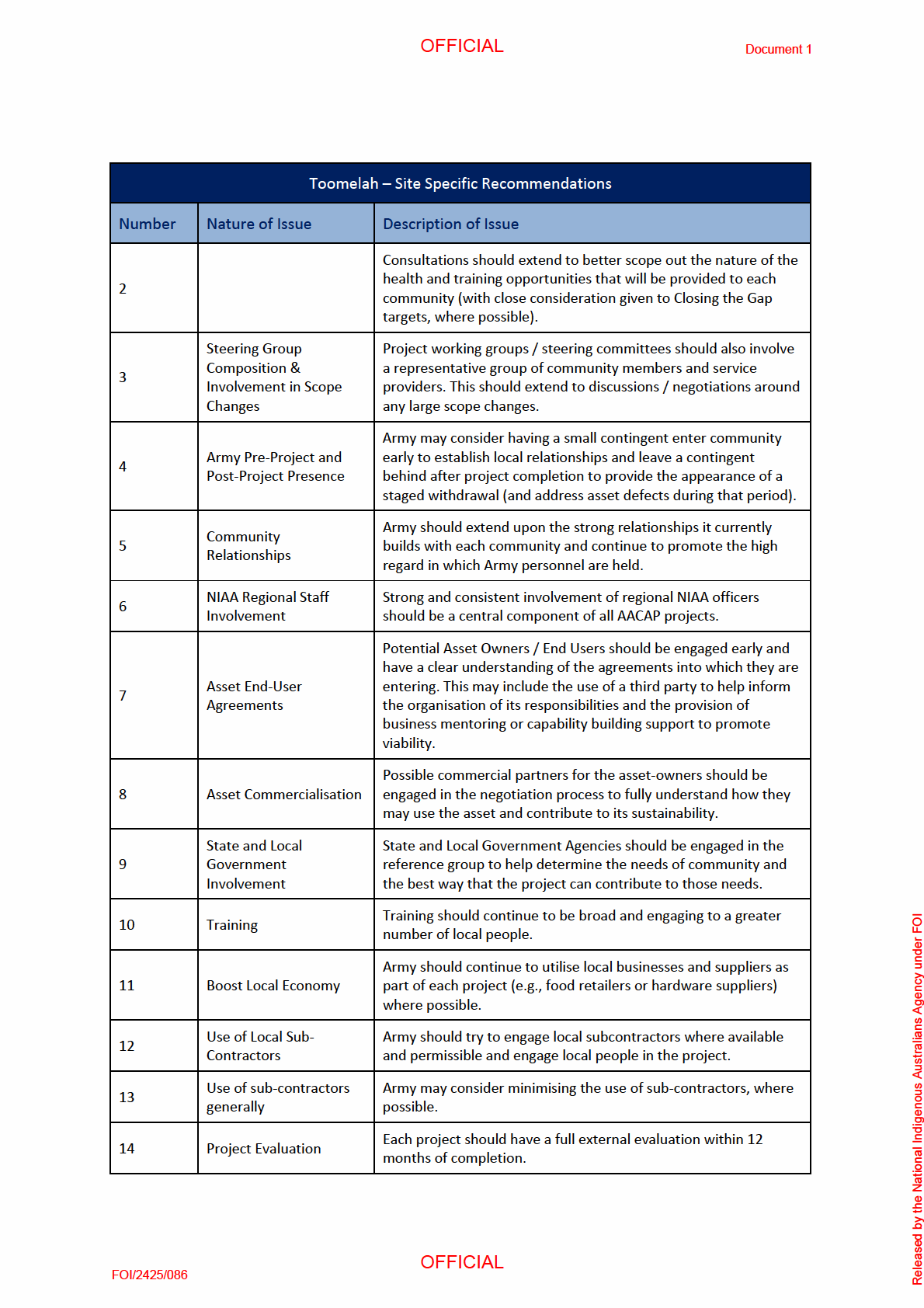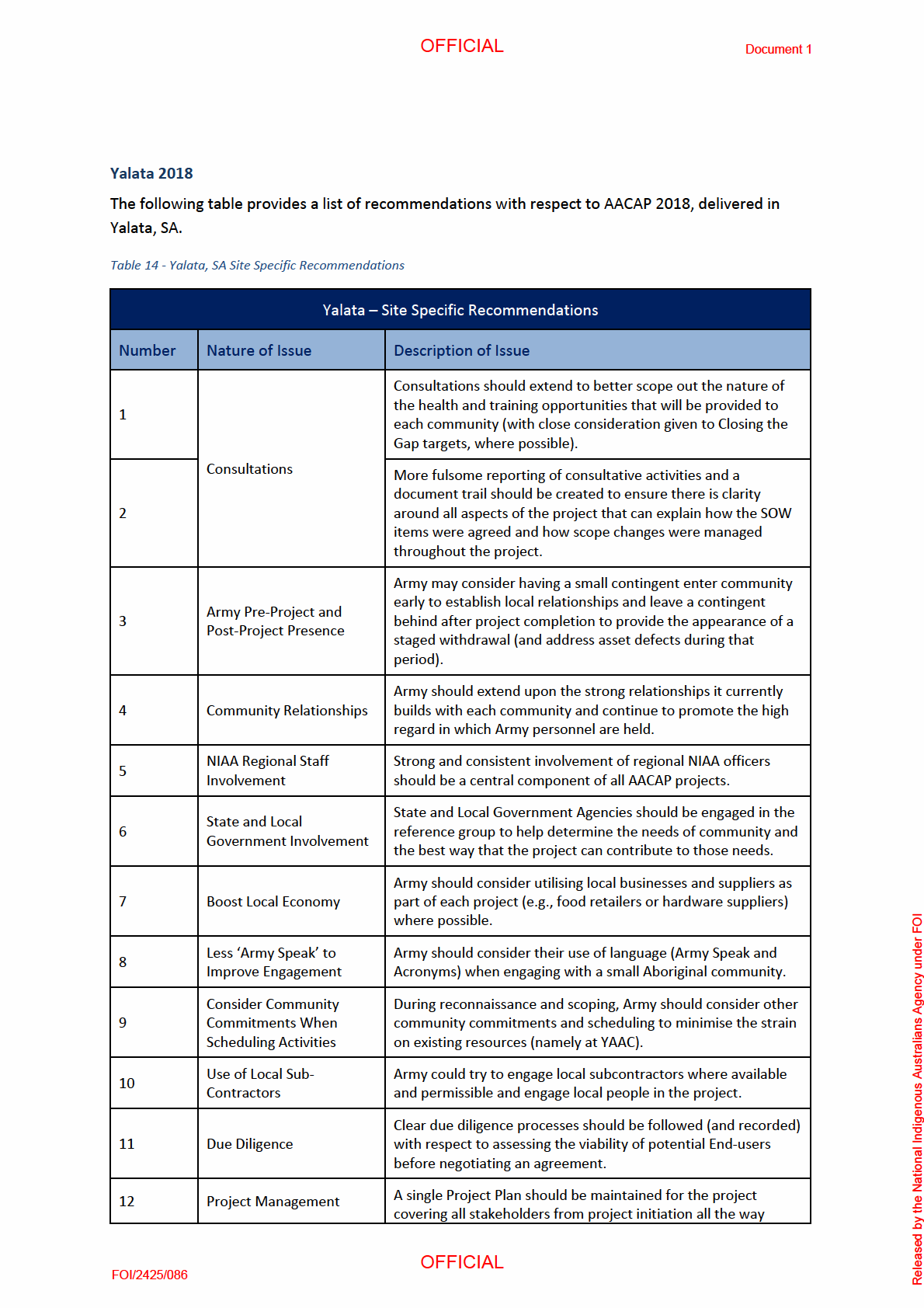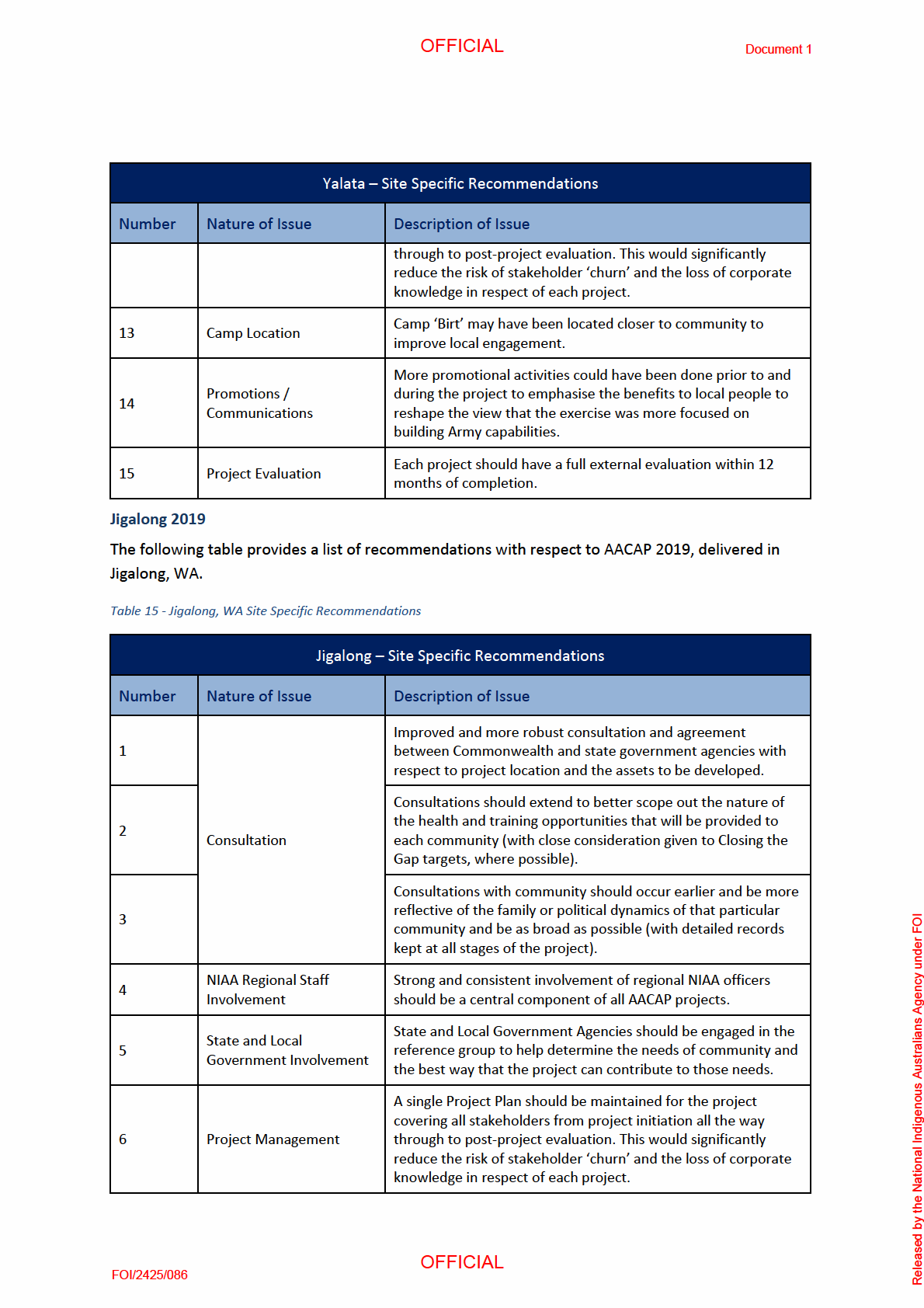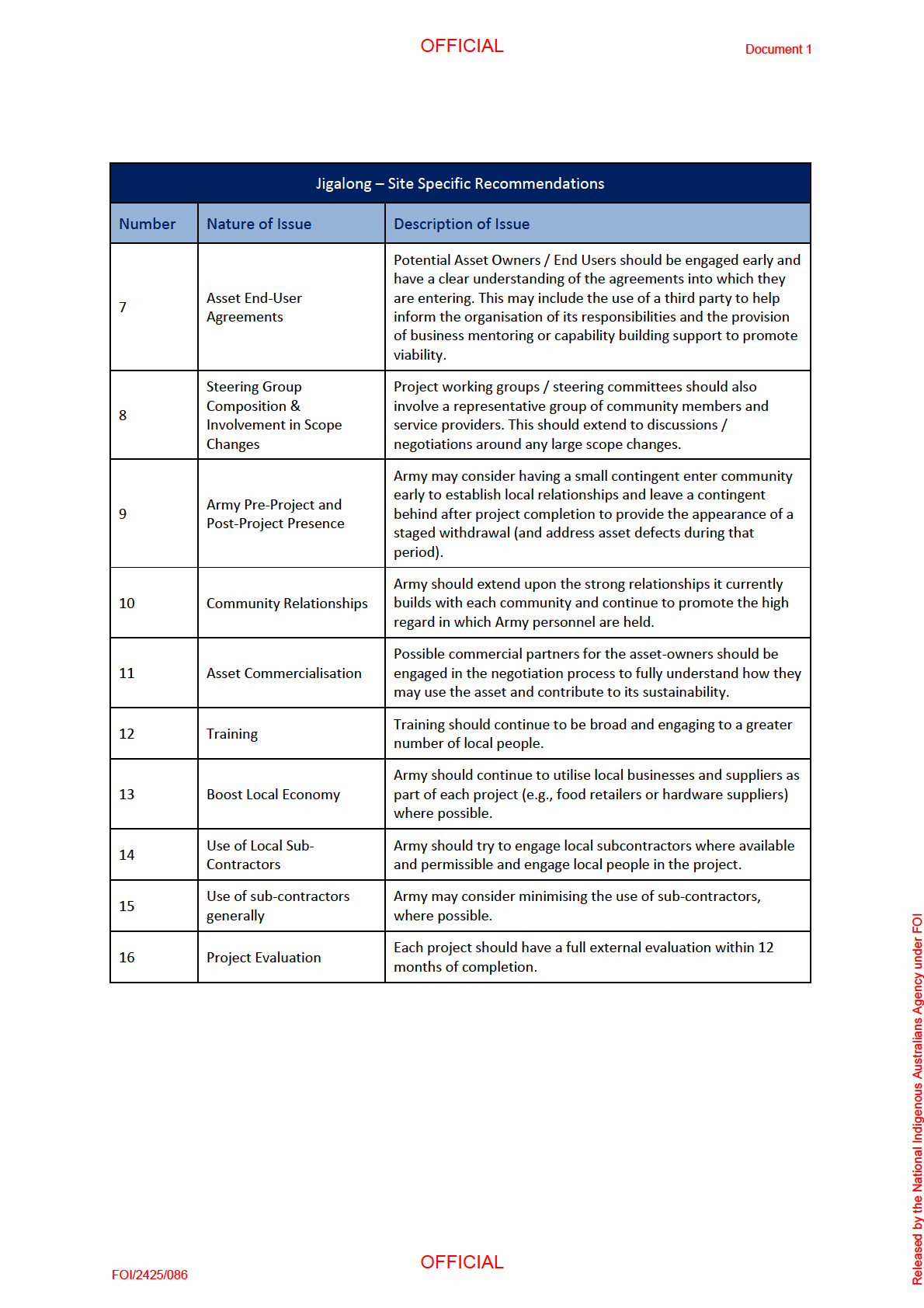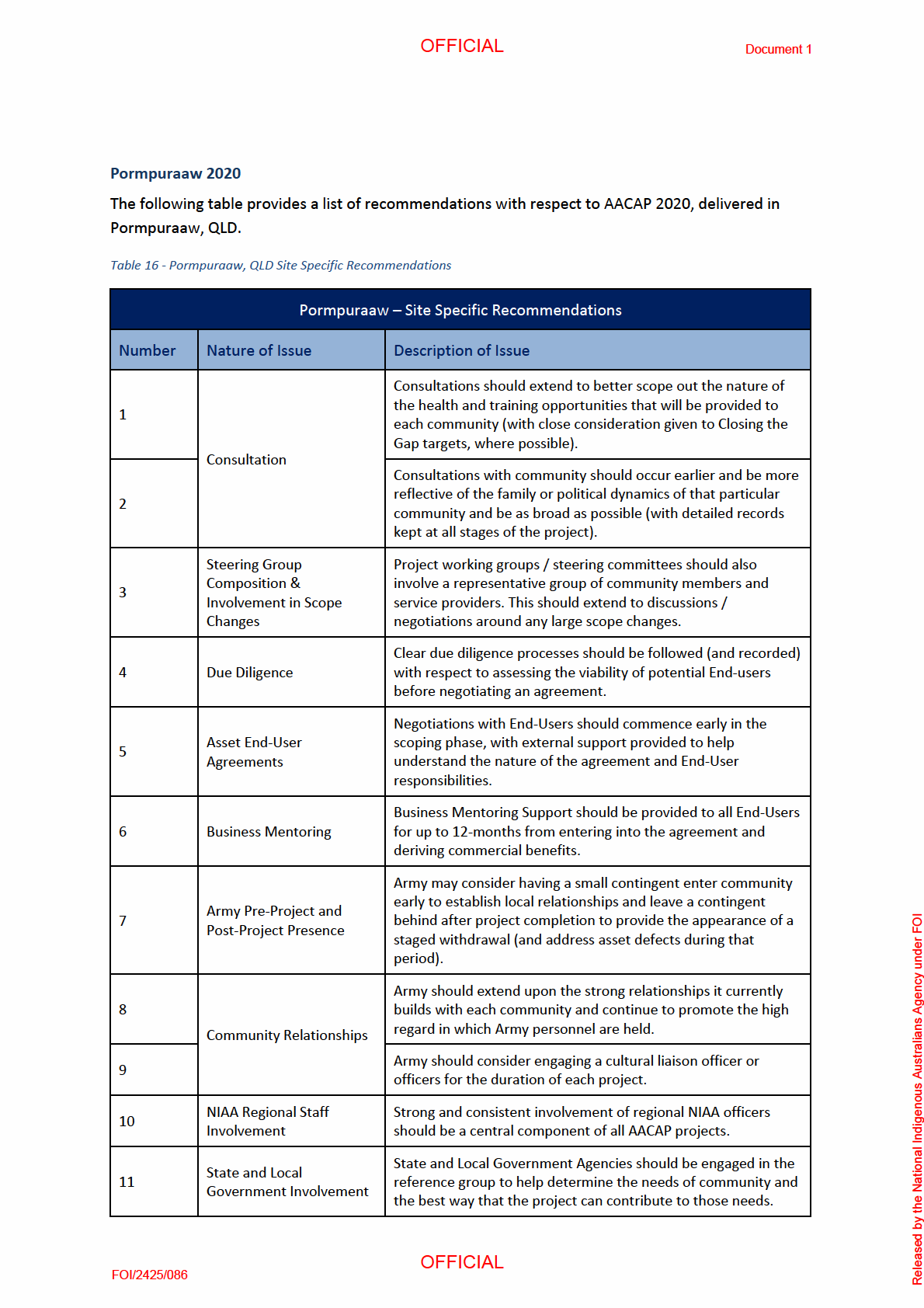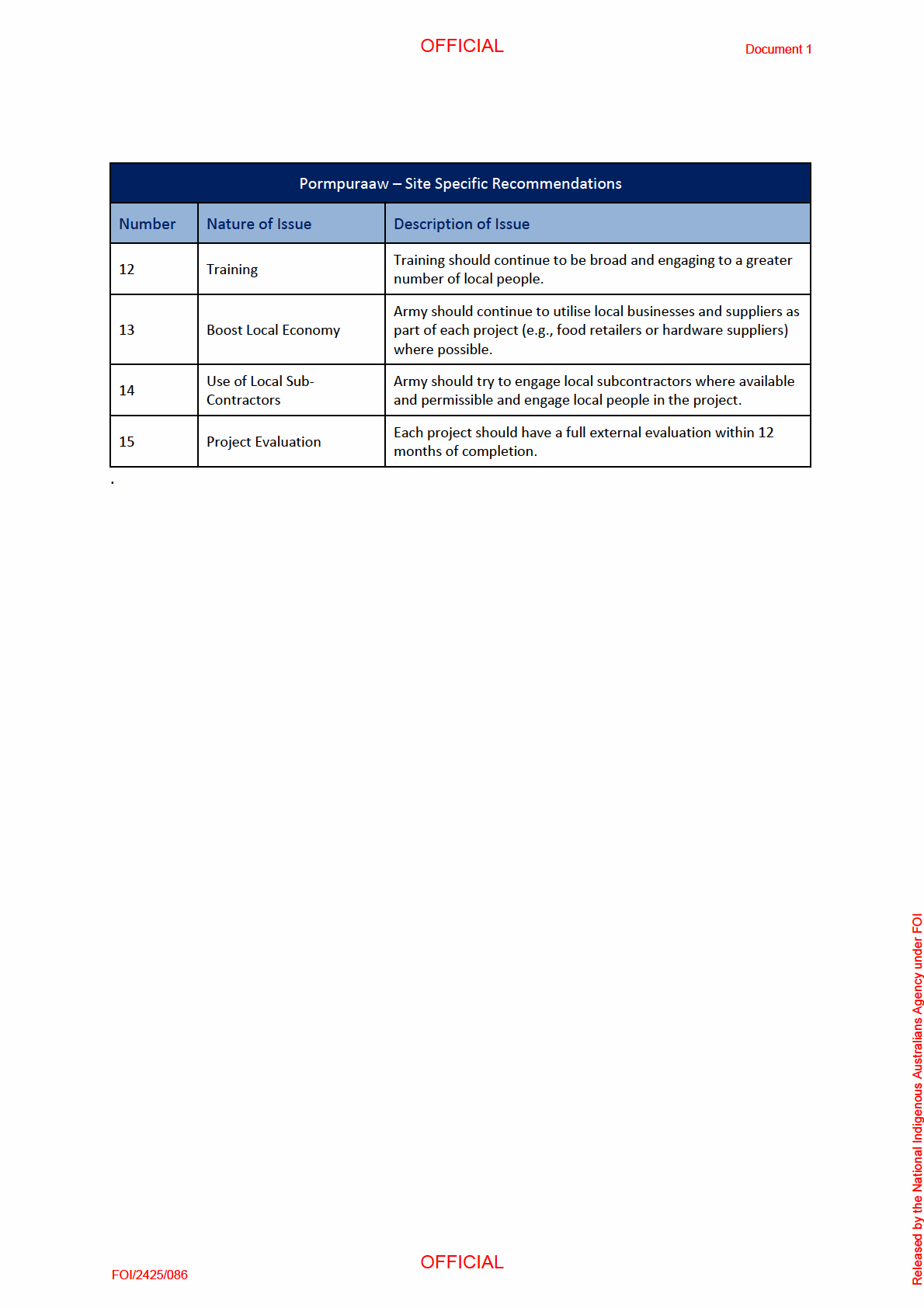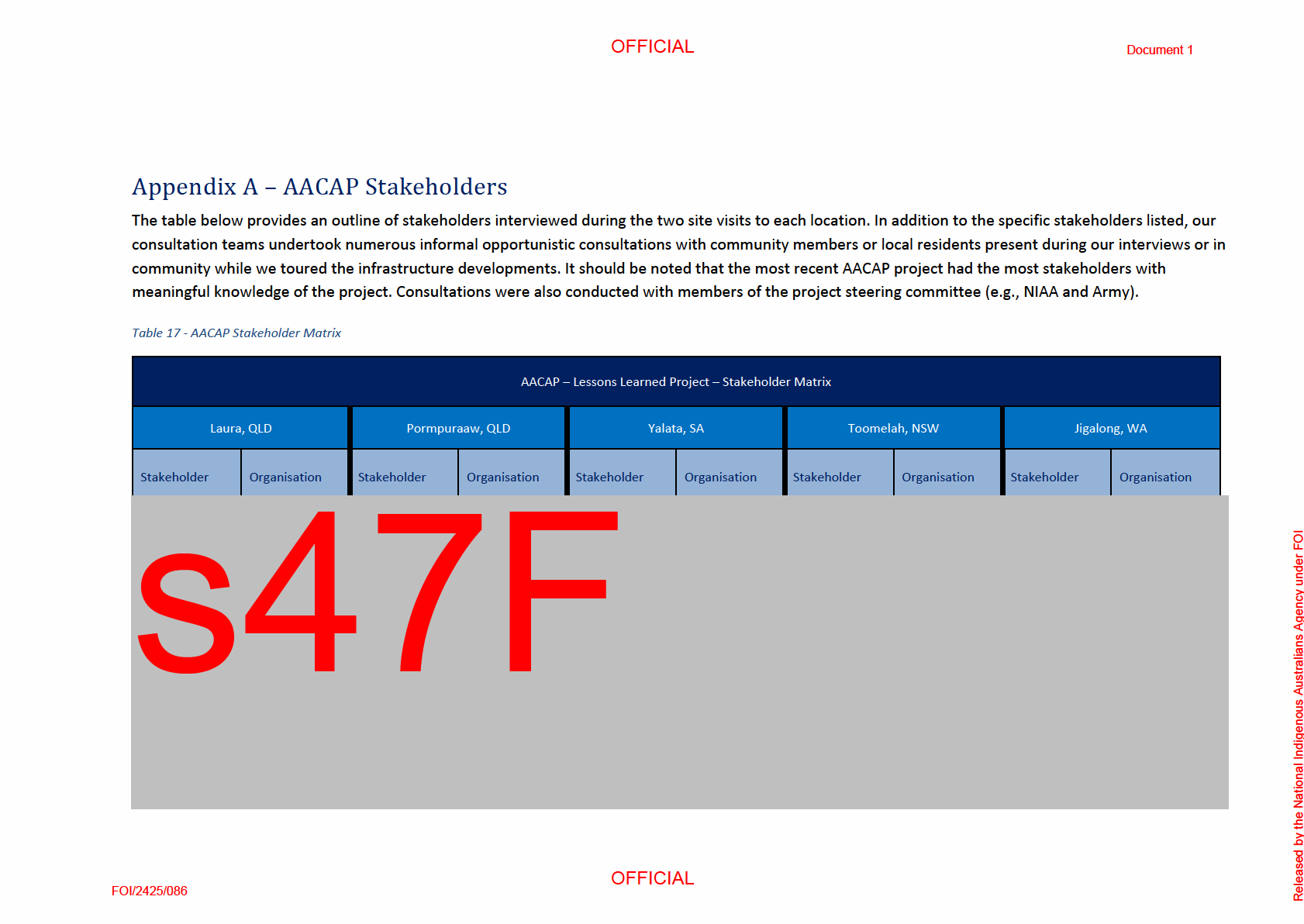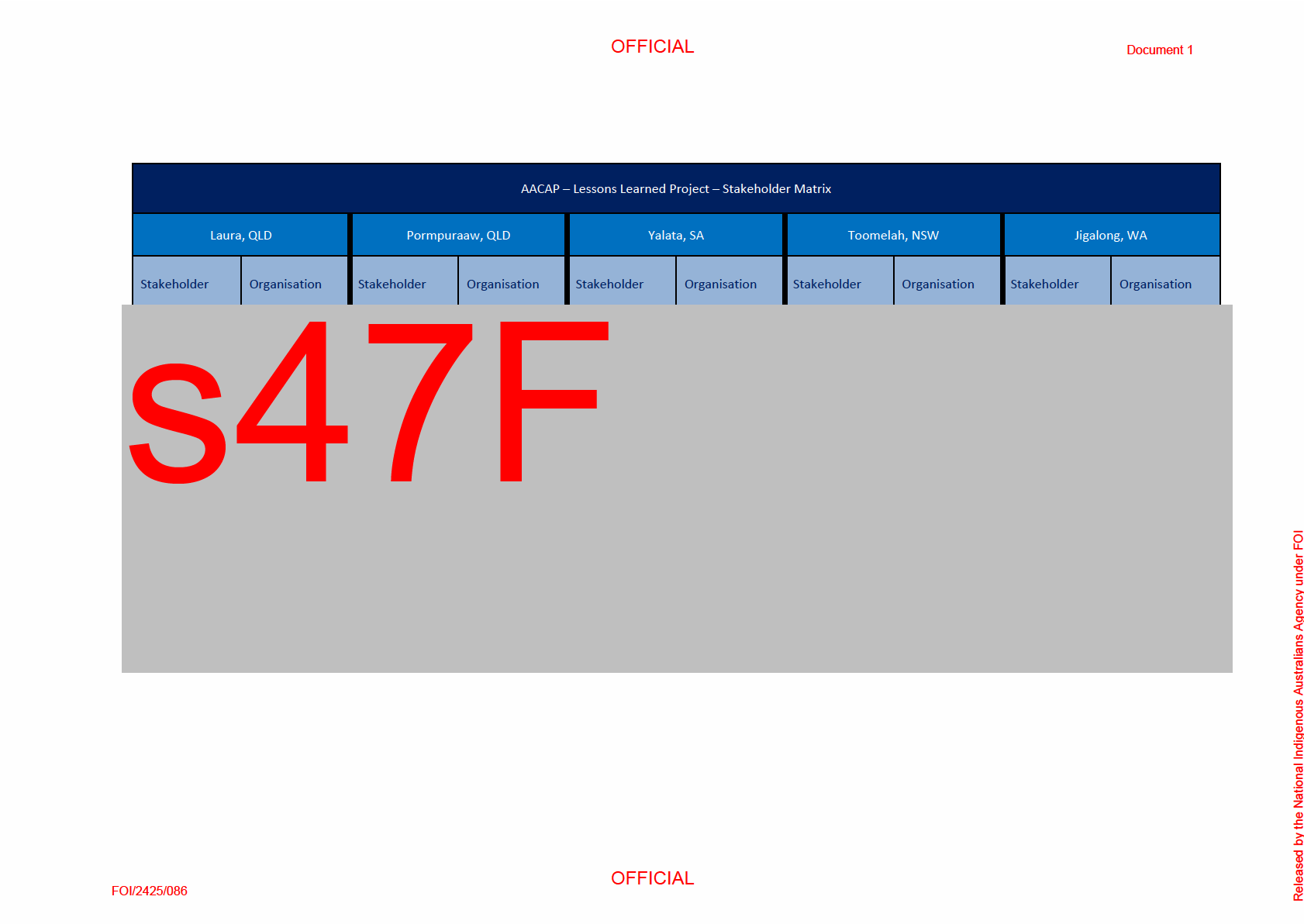
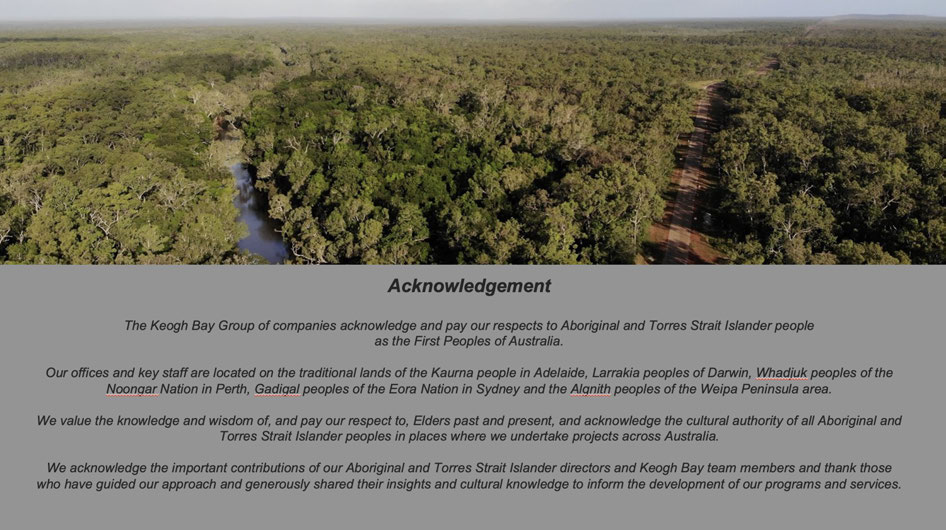
OFFICIAL
Document 1
Agency under FOI
Australians
Indigenous
by the National
OFFICIAL
FOI/2425/086
Released
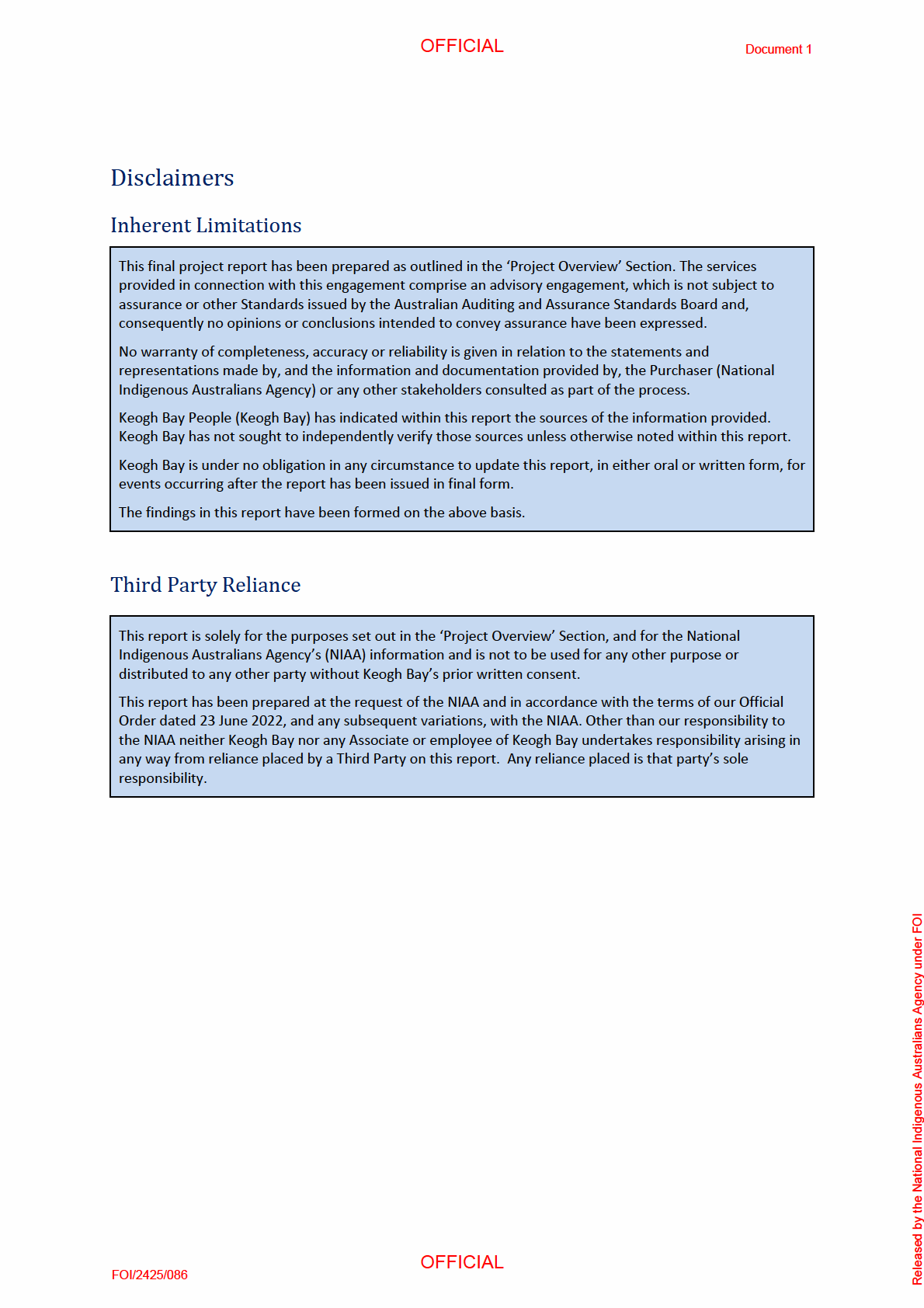
OFFICIAL
Document 1
Table of Contents
EXECUTIVE SUMMARY ................................................................................................................................... 1 INTRODUCTION ............................................................................................................................................. 6
SCOPE ................................................................................................................................................................... 6
REPORT STRUCTURE ................................................................................................................................................. 7
PRIMARY USERS OF THE REPORT ................................................................................................................................. 7
BACKGROUND ............................................................................................................................................... 8
THE ARMY ABORIGINAL COMMUNITY ASSISTANCE PROGRAMME ...................................................................................... 8
SITE SELECTION ....................................................................................................................................................... 8
SITE SCOPING ......................................................................................................................................................... 9
RECIPIENT COMMUNITY NEEDS AND SOW ................................................................................................................... 9
RECOMMENDATIONS AND VARIATIONS ...................................................................................................................... 10
THE LESSONS LEARNED PROJECT – APPROACH AND METHODS .................................................................... 11
METHODOLOGY .................................................................................................................................................... 11
Project Inception and Planning ..................................................................................................................... 11
Design and Consultation............................................................................................................................... 12
Fieldwork ...................................................................................................................................................... 13
Reporting and Project Completion ............................................................................................................... 15
AACAP PROJECTS ......................................................................................................................................... 16
AACAP 2016 – LAURA, QLD ................................................................................................................................. 16
AACAP 2017 – TOOMELAH, NSW .......................................................................................................................... 20
AACAP 2018 – YALATA, SA ................................................................................................................................... 23
AACAP 2019 – JIGALONG, WA .............................................................................................................................. 27
AACAP 2020 – PORMPURAAW, QLD ...................................................................................................................... 29
KEY FINDINGS .............................................................................................................................................. 33
CAVEATS / LIMITATIONS ON EVIDENCE ....................................................................................................................... 33
COMMON THEMES AND FINDINGS ............................................................................................................................ 33
Engagements and Partnerships with Community ........................................................................................ 34
Infrastructure Build and Upgrade to Facilities.............................................................................................. 34
Impact of Army Personnel Being in Community ........................................................................................... 35
Outcomes of Training and Development Activities ...................................................................................... 35
Healthcare and other Auxiliary Health Outcomes in the Community .......................................................... 36
Employment Outcomes ................................................................................................................................ 36
Post-Program Benefits .................................................................................................................................. 37
Additional Support Required to Help Communities Ful y Leverage al the Benefits of AACAP ..................... 37
Site Specific Findings .................................................................................................................................... 38
RECOMMENDATIONS .................................................................................................................................. 42
RECOMMENDATIONS COMMON ACROSS ALL SITES ........................................................................................................ 42
Agency under FOI
SITE SPECIFIC RECOMMENDATIONS ........................................................................................................................... 44
APPENDIX A – AACAP STAKEHOLDERS ......................................................................................................... 52
Australians
Indigenous
by the National
OFFICIAL
FOI/2425/086
Released
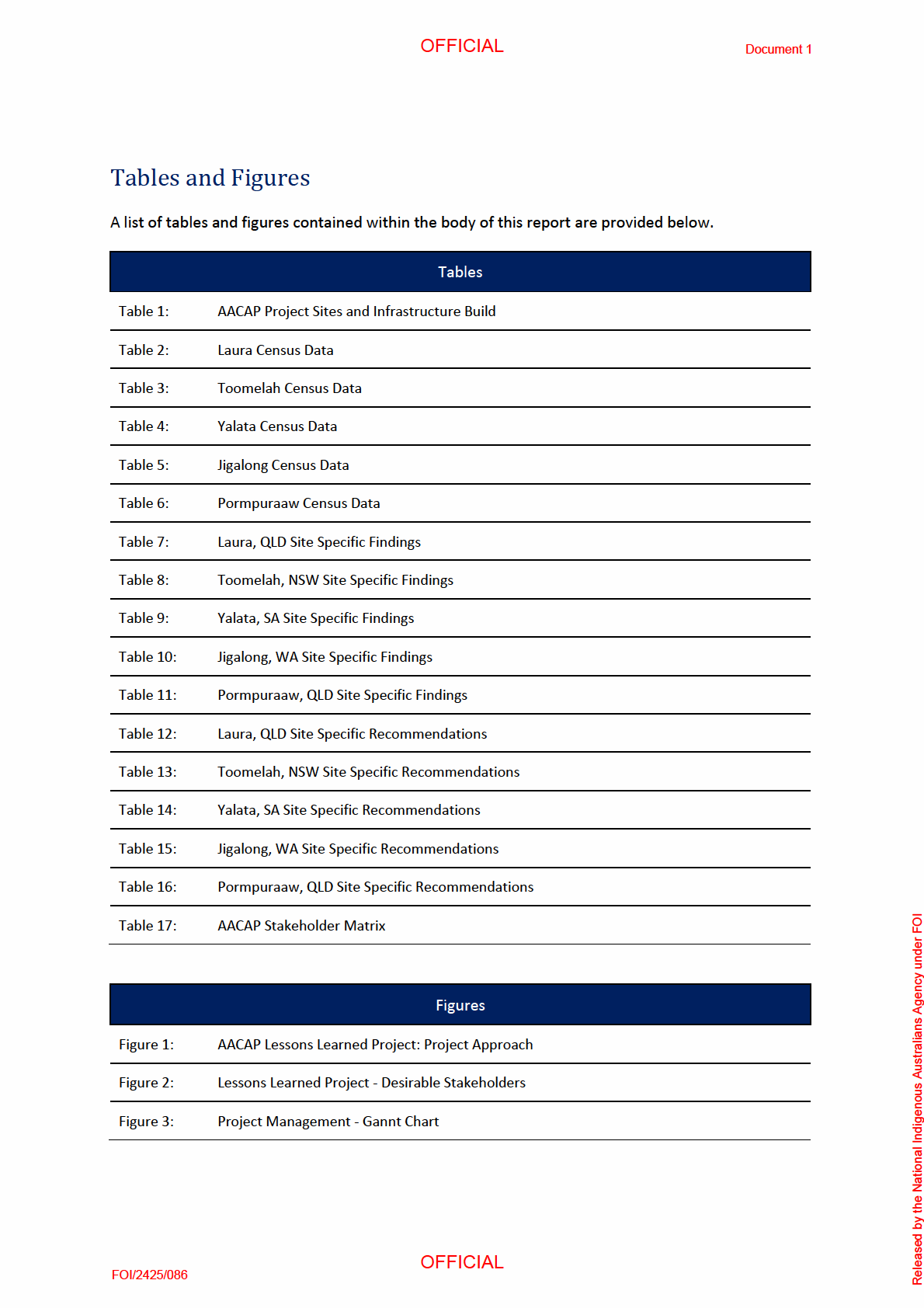
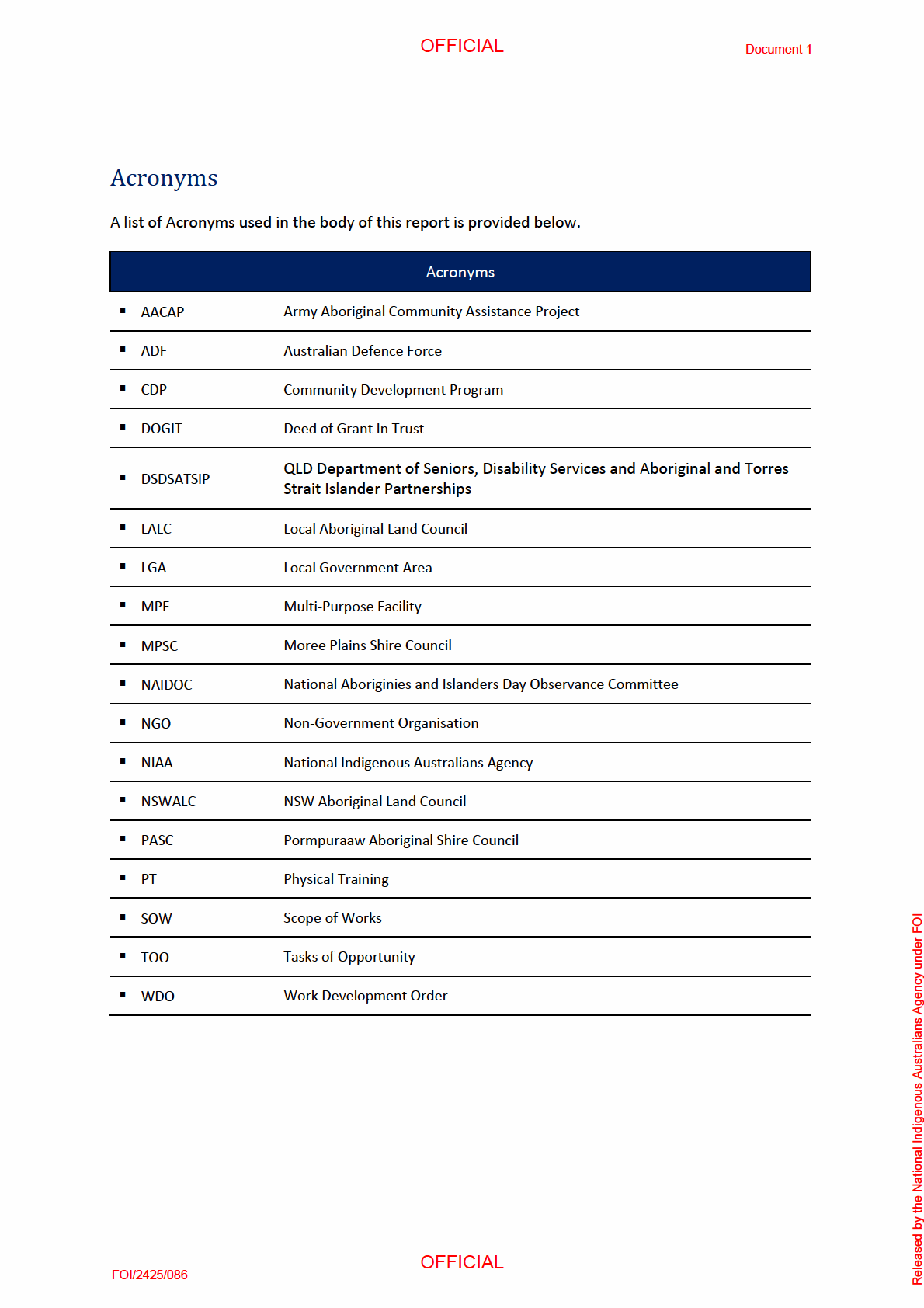
OFFICIAL
Document 1
Executive Summary
Introduction
The National Indigenous Australians Agency (NIAA) engaged Keogh Bay People (Keogh Bay) to
undertake a Lessons Learned Project to support learning, development, and adaptation of the Army
Aboriginal Community Assistance Programme (AACAP). Focussing on the most recent five AACAP
projects, this engagement centred on:
engagements and partnerships with community
infrastructure build and upgrade to facilities
impact of Army personnel being in Community
outcomes of training and development activities
healthcare and other auxiliary services and their links to improved health outcomes in community
employment outcomes
post-programme (legacy) benefits, and
additional support required to help Communities fully leverage all the benefits of AACAP.
Our team considered options on how the structure and aims of AACAP could be adapted to better
support economic independence within community and maximise longer term health and social
outcomes (and progress towards the aims and targets of the ‘Closing the Gap’ Agreement).
Background
The AACAP, which began in 1997, works with a remote community each year to build infrastructure
and provide health services for local people. AACAP is allocated annual funding of $7 million, which is
matched with an in-kind commitment of support from the Australian Army. The initiatives focus on
delivery of infrastructure, health care and training as well as enabling Aboriginal and Torres Strait
Islander Peoples’ participation in the Australian economy. The projects also provide Army personnel
with important training opportunities.
Each AACAP project has three key elements, which are construction, health, and training. Since its
inception, projects have delivered a mix of housing, road construction / upgrades, sewerage
treatment plants, airfield construction or upgrades, health clinics, telecommunications infrastructure,
school upgrades, potable water supply infrastructure, and housing subdivisions.
More recently, the program's focus has extended to training programs, which are tailored training
courses developed with community and linked to any local employment opportunities as well as
health programs, including community health, al ied health and other services, and veterinary
services.
Communities
Agency under FOI
The diagram that fol ows depicts each of the last five AACAP projects, when they were undertaken,
and the broad nature of the infrastructure developed.
Australians
Indigenous
by the National
OFFICIAL
FOI/2425/086
Released
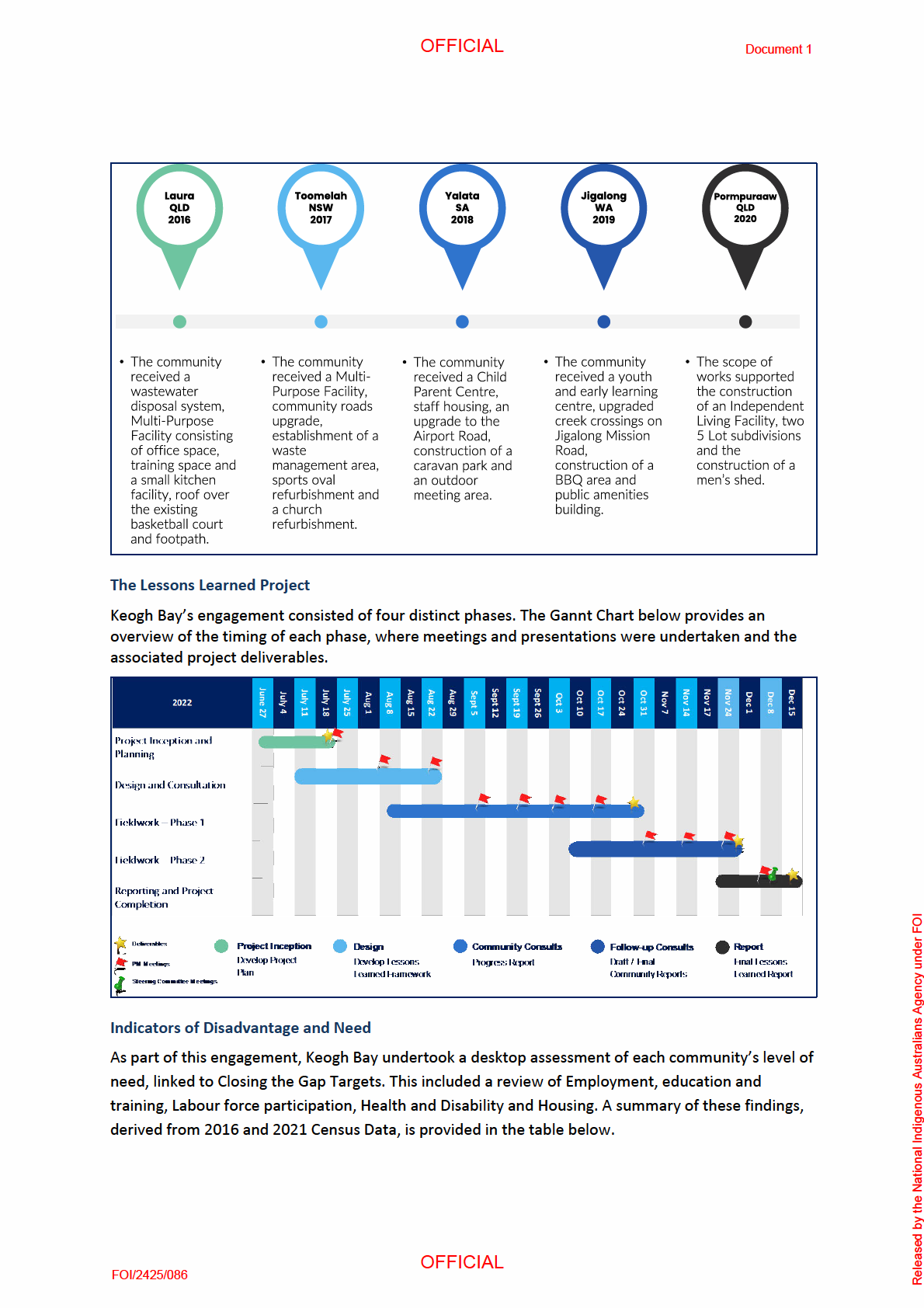
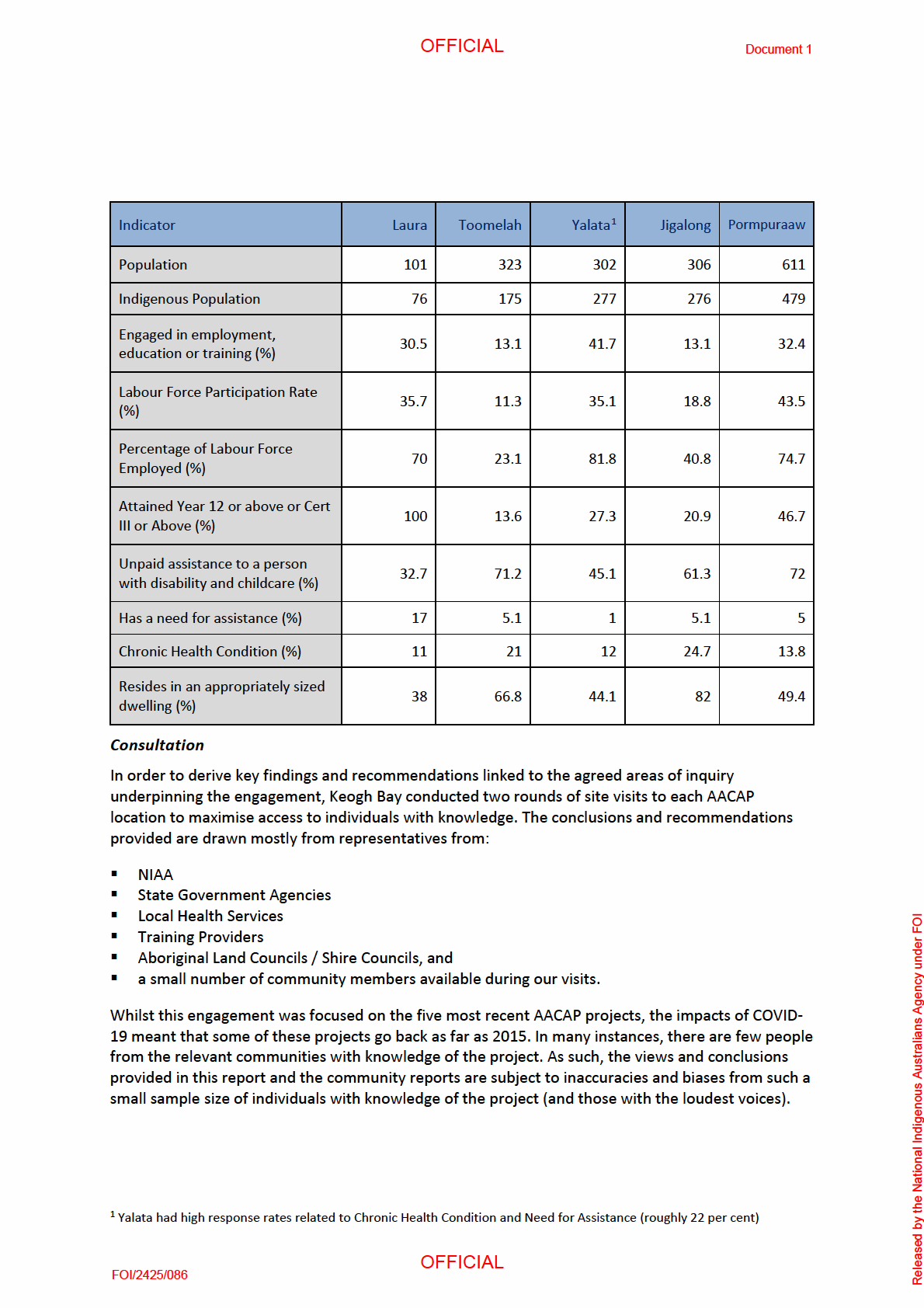
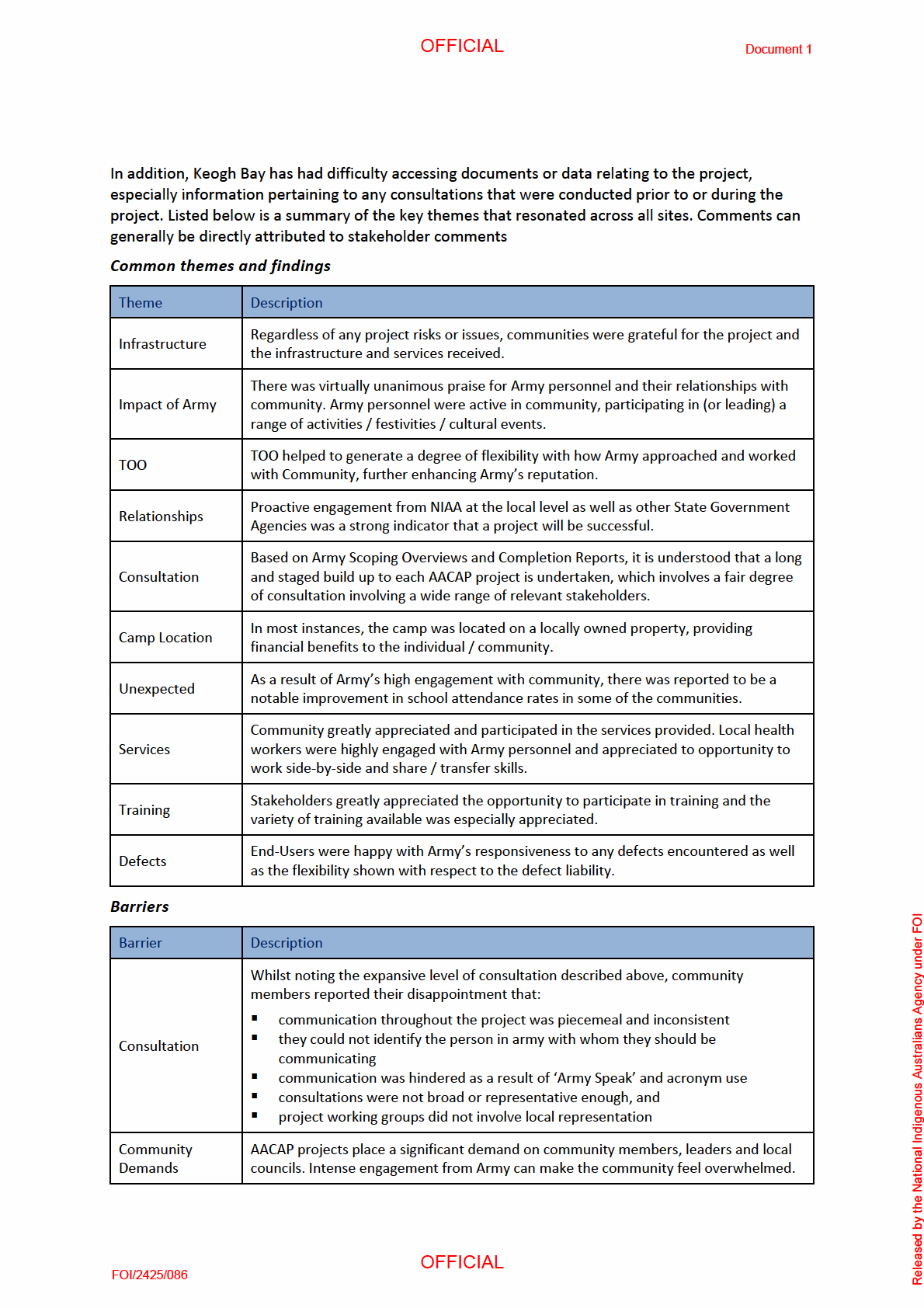
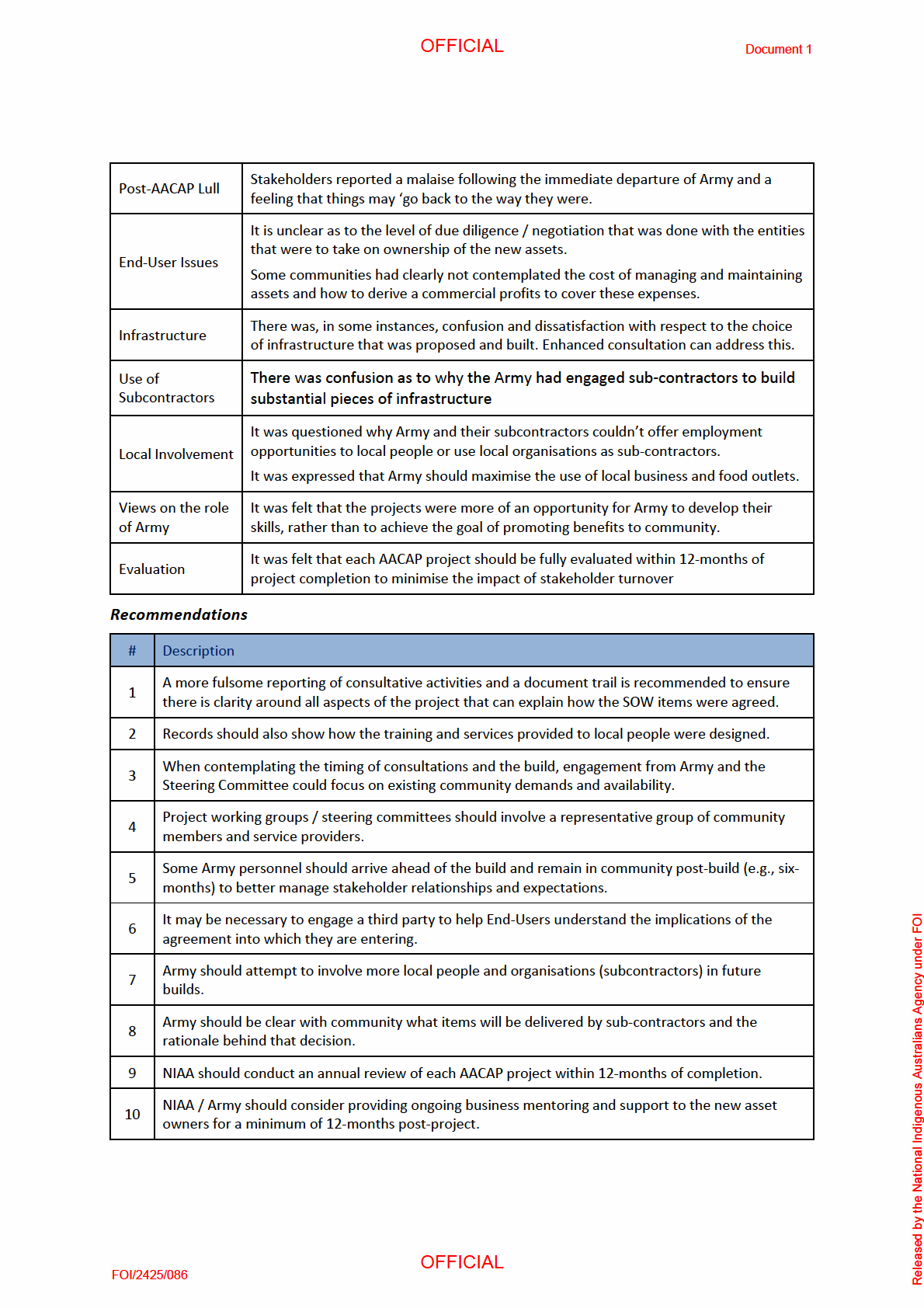
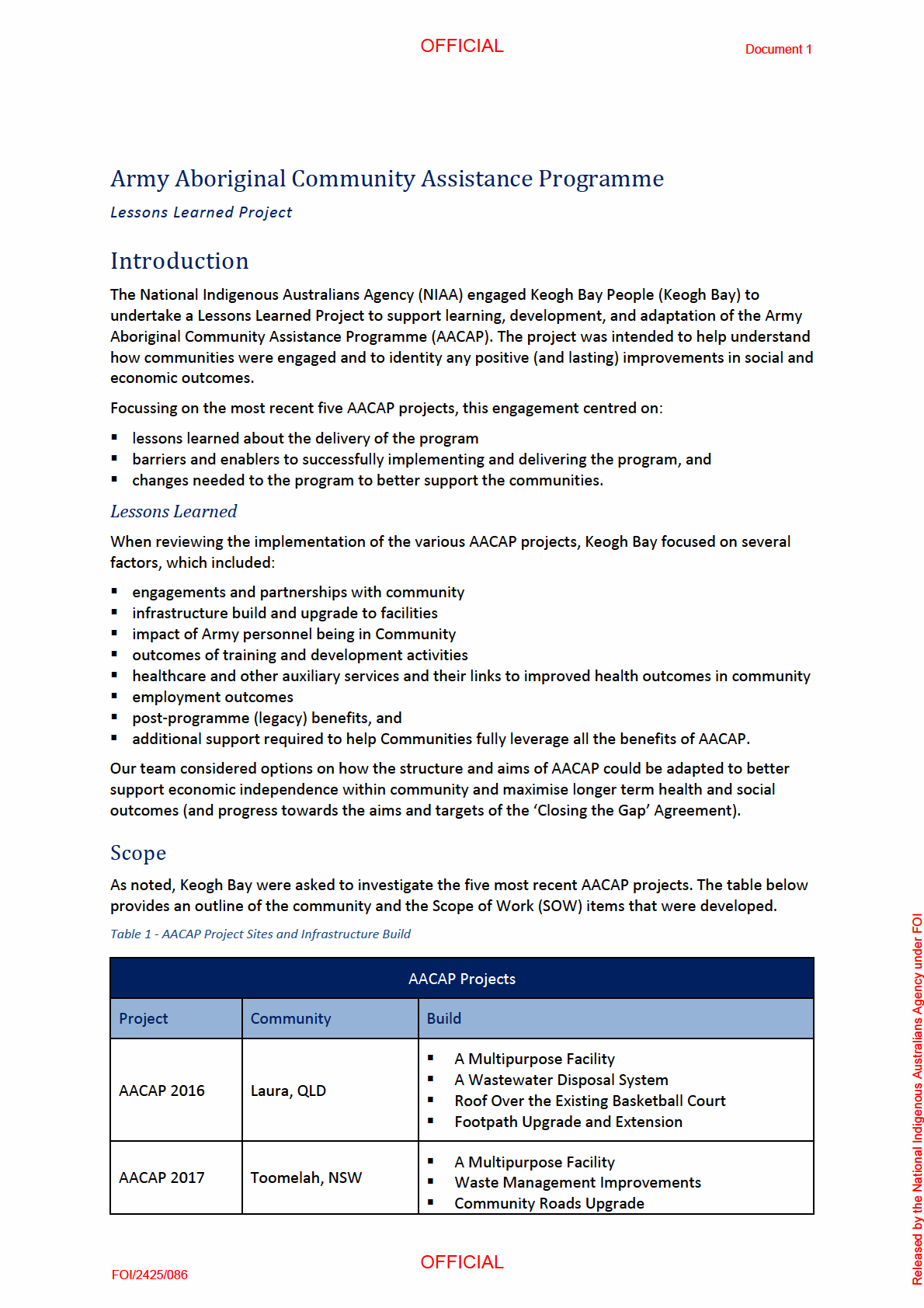
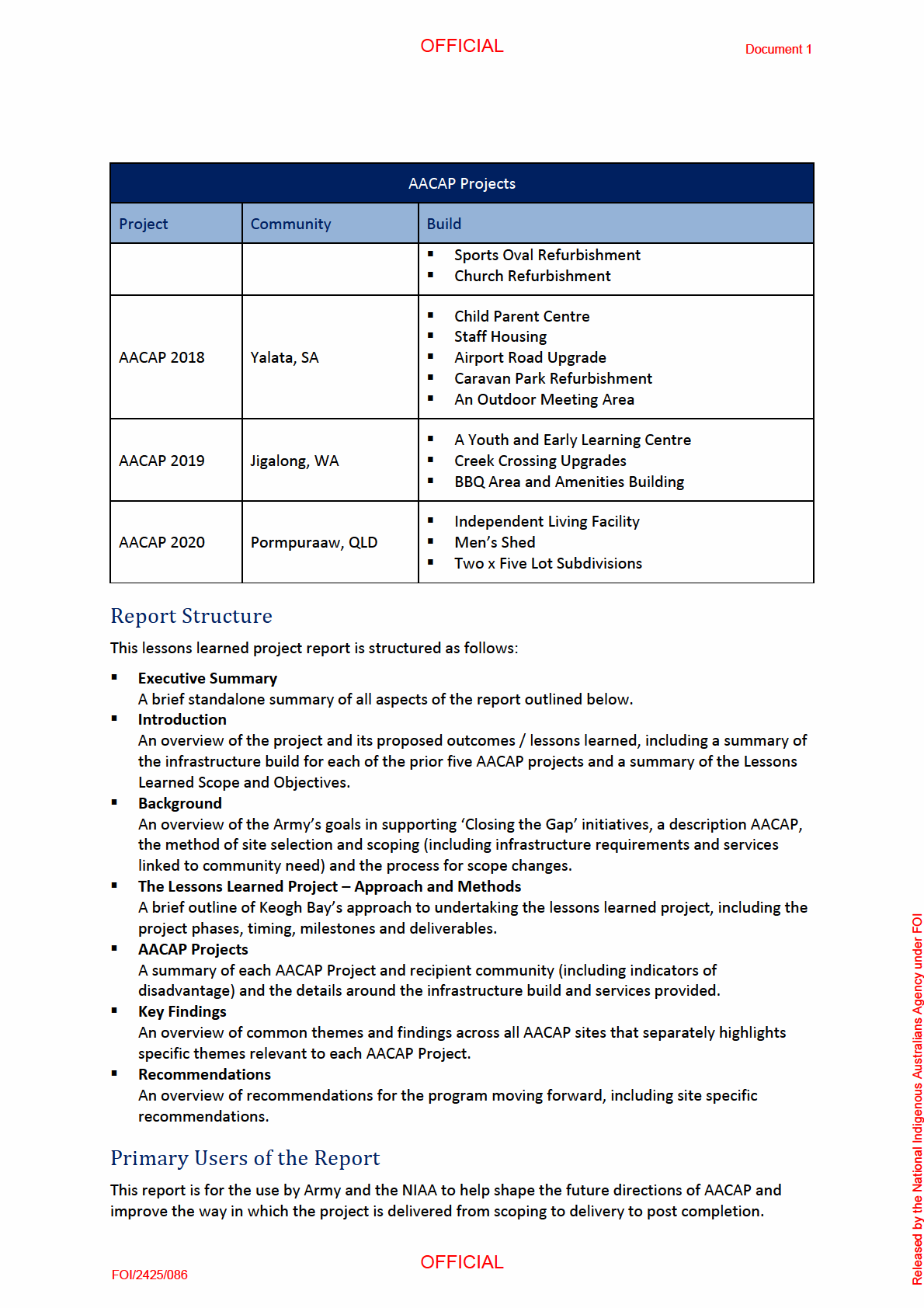
OFFICIAL
Document 1
Background
The Australian Army (Army) is strongly committed to the Whole of Government ‘Closing the Gap’
strategy and the Defence Reconciliation Plan 2019 - 2022. In line with its goals, the Army seeks to
support ‘Closing the Gap’ initiatives through the delivery of infrastructure, health care and training as
well as enabling Aboriginal and Torres Strait Islander Peoples’ participation in the Australian
economy.
The Army’s three key action areas are:
Relationships
→ Build mutual y beneficial relationships between units and Aboriginal and Torres Strait Islander
Peoples and Communities where Army personnel live, work and exercise.
Respect
→ Cultivate a deep understanding and respect for Aboriginal and Torres Strait Islander cultures,
histories and contemporary matters across Army.
Opportunities
→ Increase Aboriginal and Torres Strait Islander participation in the Australian economy by
providing development, employment and procurement opportunities.
The Army Aboriginal Community Assistance Programme
Beginning in 1997, the Army Aboriginal Community Assistance Programme (AACAP) works with a
new remote community each year to build infrastructure and provide health services for local
people. AACAP is allocated annual funding of $7 mil ion, which is matched with an in-kind
commitment of support from Army. The initiatives focus on delivery of infrastructure, health care
and training as well as enabling Aboriginal and Torres Strait Islander Peoples’ participation in the
Australian economy. The projects also provide Army personnel with important training opportunities.
Each AACAP project has three key elements, which are construction, health, and training. Since its
inception, projects have delivered a mix of housing, road construction / upgrades, sewerage
treatment plants, airfield construction or upgrades, health clinics, telecommunications infrastructure,
school upgrades, potable water supply infrastructure, and housing subdivisions.
More recently, AACAP’s focus has extended to training programs, which are tailored training courses
developed with Community and linked to any local employment opportunities as well as health
programs, including community health, allied health and other services, and veterinary services.
Site Selection
In conjunction with Army, the CEO of NIAA ultimately determines the community that wil be the
ACAAP recipient for that particular year. Multiple sites are considered by Army and the CEO on the
basis of feedback provided by State and Territory NIAA representatives and State Government
Agencies. For example, this included agencies such as the Department of Seniors, Disability Services
Agency under FOI
and Aboriginal and Torres Strait Islander Partnerships (DSDSATSIP) in Queensland and the NSW
Aboriginal Land Council (NSWALC) for NSW-related sites.
Submissions are then assessed against Project Guidelines by NIAA, with support from Army, and an
Australians
agreed shortlist of potential recipient communities is provided to the NIAA CEO for approval.
Identification and selection of each AACAP site considers a number of factors, including:
Indigenous
AACAP objectives
NIAA’s policy requirements
previous rounds of AACAP
Army’s desired programme outcomes, training requirements and capabilities
by the National
OFFICIAL
FOI/2425/086
Released
OFFICIAL
Document 1
potential Scope of Works (SOW), including construction, training and developmental activities
achievability of Access Rights and land-tenure arrangements
community self-nomination and demonstration of ownership, governance and leadership
recommendations from NIAA Regional Offices, and
advice from the relevant state government agencies, where necessary, and an indication of
further support through a financial contribution, in-kind support or some other outcome of
value.
Shortlisted communities are then invited to submit project bids.
Site Scoping
Once applications are received from shortlisted sites, Army (with NIAA support) will conduct an initial
reconnaissance visit to each site up-to two years ahead of project delivery. Generally, the Army
Construction Agency is involved in consultations to help identify any issues with respect to their
ability to deliver scoped items, thereby refining possible SOW (and where subcontractors may be
required to develop some SOW items).
A Feasibility Study is then completed for the AACAP Steering Committee, for the shortlisted
communities, which includes the identification of potential SOW items.
These visits involve:
Engagement with key local stakeholders and end-users
→ Consultations are undertaken to help obtain a clearer picture of the community and develop
an understanding of the local service sector and organisations operating within the
community.
Community Scoping
→ Community are engaged through the local Aboriginal Land Council (LALC), or other
representative body, with the intention of discussing the needs of the community and the
SOW, as wel as project timelines and approvals.
Stakeholder Engagement
→ Broader meetings are also conducted with representatives from a range of potential
stakeholders, which general y include staff from local service providers and local State and
Government Agencies. The level of consultation is tailored to the dynamics of each
community.
Recipient Community Needs and SOW
Once a recipient community is formal y approved by the NIAA CEO, a more detailed scoping process
is undertaken. This method is used to further develop information on the community that was
obtained during the Feasibility Study and provided more tailored recommendations for the Project.
A Scoping Study Report is then completed for the Steering Committee, which acts as the approval
mechanism for the SOW to be developed, and support the establishment of an initial Project budget
Agency under FOI
allocation.
Scoping consultations also consider the services that community is likely to receive during the
project, which is based upon participant feedback and a detailed review of the local service sector,
Australians
including organisations that deliver services to the community.
Indigenous
by the National
OFFICIAL
FOI/2425/086
Released
OFFICIAL
Document 1
Services have generally included:
Medical
Dental
Environmental Health
Health and Wellbeing
Veterinary
Scoping also considers training and employment requirements or desired outcomes and are
general y linked to the SOW. Training varies slightly from site to site, but has included:
Certificate II in Construction Pathways
Certificate I in Hospitality
Photography Training
White Card Certification (for construction)
Responsible Service of Alcohol certification
First Aid
A Letter of Acceptance or ‘Workscope Letter’ is issued from the Scoping Study Report to the
community and is used to obtain formal community acceptance to conduct the proposed AACAP
Project and SOW. This letter is signed by local body representing that community or other relevant
organisation or group of individuals.
Once agreed to by the NIAA and on execution of the Workscope Letter, Army begins moving into the
design phase for that project.
Recommendations and Variations
Throughout the project design and delivery phases, continual changes to the SOW and Task of
Opportunity (TOO) items are made on the basis of:
ongoing consultations with community
budget
practical realities
Army capability, and
co-contributions from other organisations (e.g., State Government Agencies).
Some SOW items are delivered in a flexible manner or to a design stage only so as to provide some
flexibility with respect to budgetary constraints.
Agency under FOI
Australians
Indigenous
by the National
OFFICIAL
FOI/2425/086
Released
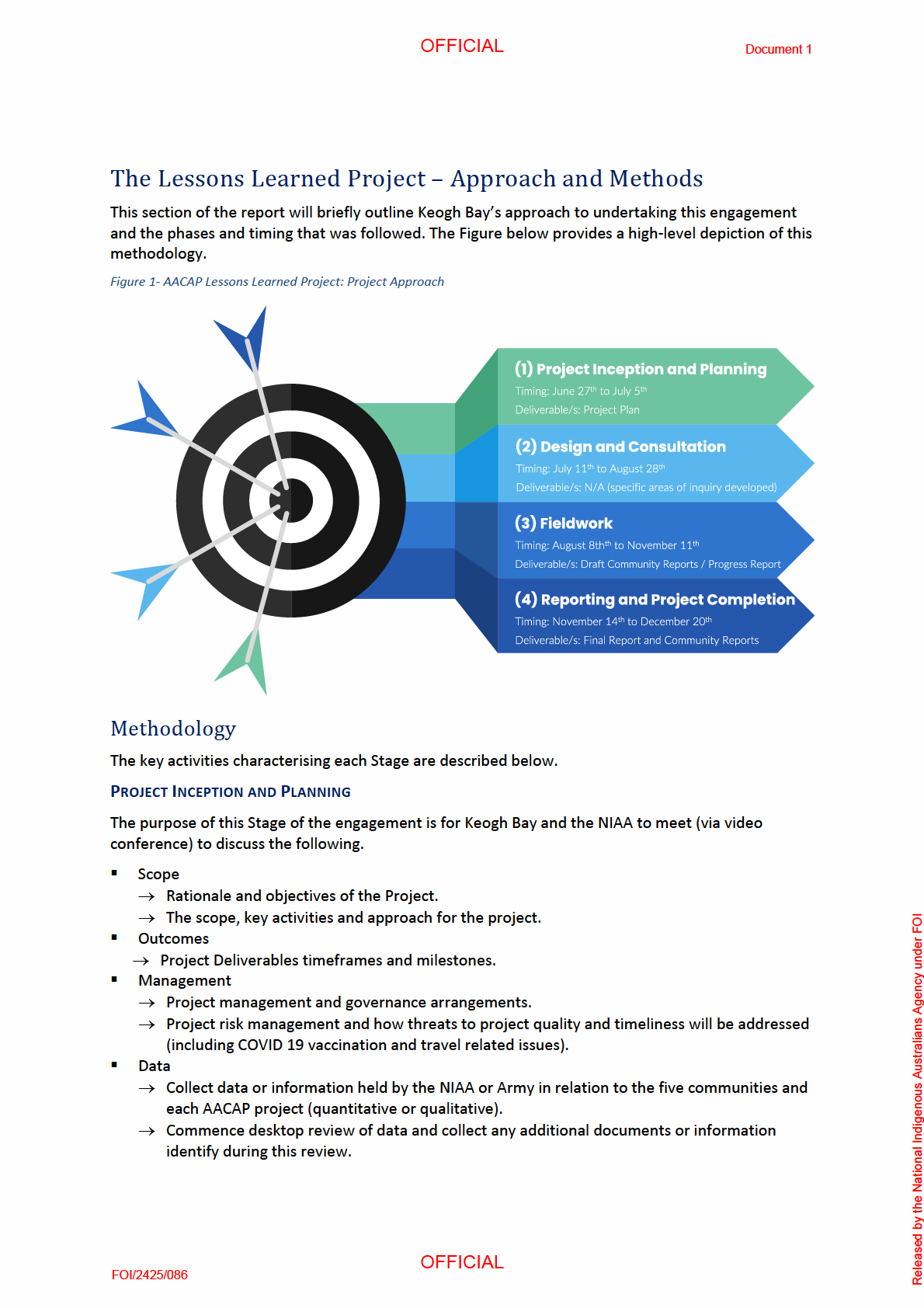
OFFICIAL
Document 1
Meetings
→ Project management meeting requirements (including locations and times).
→ Contact methods for key stakeholders within the NIAA and Australian Army (and other
AACAP Steering Committee members).
→ A communication strategy that maps key stakeholders and outlines how and when they will
be engaged throughout the project.
Deliverable
→ Our project developed a Project Plan incorporating al this information, which was used to
guide the remainder of the engagement.
DESIGN AND CONSULTATION
The purpose of this Stage of the engagement was to design a culturally appropriate ‘lessons learned
framework’ to guide the subsequent fieldwork. This was characterised by a desktop review and
consultations with key stakeholders to guide our approach. In order to accomplish this, our team:
undertook a desktop review of each AACAP project and the various infrastructure, training,
community health and associated services provided (where relevant)
reviewed any pertinent baseline data col ected during Project Inception to understand
fundamental pre-existing local issues linked to health, social and emotional wellbeing, training
and employment activity / outcomes, economic participation and progress towards other stated
Closing the Gap socio-economic targets (where available).
assessed the quality and availability of data that can be used for comparative purposes, and
developed a draft Framework that could be tested with key project stakeholders.
Testing and Refinement
Once developed, the Framework was tested, refined, and expanded based on the views of key
project stakeholders (external to community) and closely linked to the AACAP Steering Committee.
Scope of consultations
Input into the Framework was mostly derived directly from NIAA’s Project Management team.
Where necessary, it was modified slightly to suit the needs of stakeholders on-the-ground, during our
site visits.
Areas of inquiry
Broadly, the Framework was intended to answer the following questions:
How does AACAP operate and what lessons are there about the delivery of the program?
What are the barriers and enablers to successfully implementing and delivering AACAP
outcomes?
What should AACAP continue to do?
What should be done differently?
What changes are needed to support communities to maximise the opportunities provided by
Agency under FOI
the AACAP?
Stakeholder consultations were asked to provide site-specific responses to the following areas of
inquiry:
Australians
Scoping
→ The basis on which the was community selected.
→ Key indicators of need / disadvantage (closing the gap).
Indigenous
→ The level of community involvement in scoping and design.
by the National
OFFICIAL
FOI/2425/086
Released
OFFICIAL
Document 1
Project Synopsis
→ Overview of the build.
→ Project links to the need identified above (and how that need was identified).
→ The extent to which SOW items matched scoping discussions.
→ Any defects.
→ The extent to which the project meet those identified needs (outcomes).
Relationships
→ Relationships between stakeholders with local Council, End-Users and Community:
o Army
o NIAA
o Local and State Government Agencies
o Service providers supporting that community
o Other local service providers
Skill Development
→ Use of local people in project delivery.
→ Use of local organisations as sub-contractors.
→ Training delivered (formal / informal).
→ Employment outcomes and sustainability.
Economic Impact
→ Organisational Level.
→ Community Level.
→ Individual Level.
Impact of non-Infrastructure activities (service delivery)
→ Health
→ Environmental Health
→ Physical Training
→ Dental
→ Veterinary
Links to need (Closing the Gap targets)2
→ Long and healthy lives (Target 1)
→ Education and Training (Target 6)
→ Employment (Target 7 and 8)
→ Access to appropriate and affordable housing (Target 9)
→ Social and emotional wellbeing (Target 14)
Additional support required to ful y embed the benefits.
FIELDWORK
During this phase, our Keogh Bay consultation teams undertook two rounds of fieldwork at each of
the AACAP project sites listed earlier. Our teams included at least one Aboriginal and / or Torres
Strait Islander person.
Agency under FOI
Australians
Indigenous
2 It is obvious that long-term improvements with respect to Closing the Gap targets wil not be evident during the project or
the immediate term. Where possible we have identified where activities wil support the achievement of these targets (e.g.,
training provided, Certificates achieved, employment secured as a result of services provided, Health and Wel being
services provided).
by the National
OFFICIAL
FOI/2425/086
Released
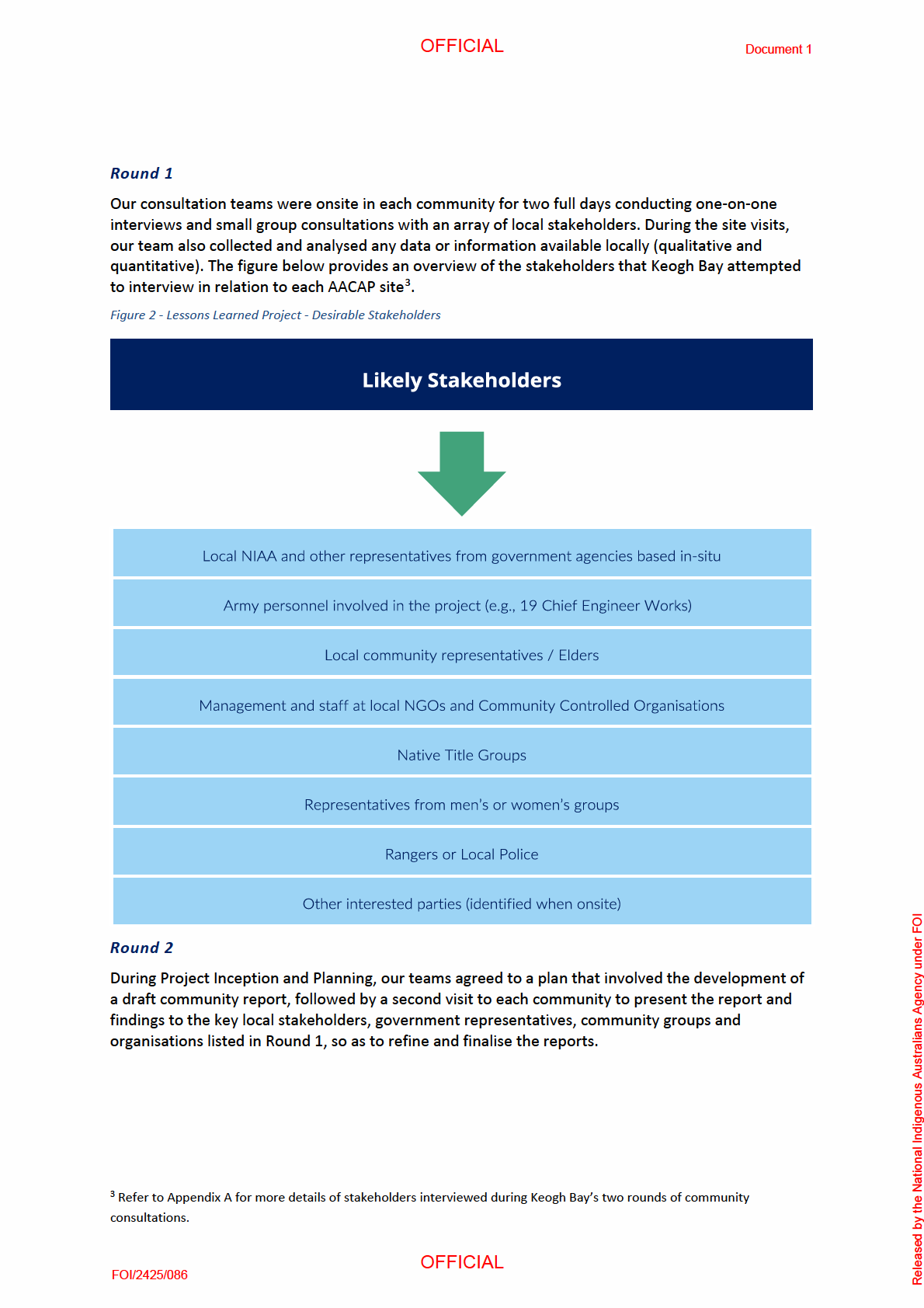
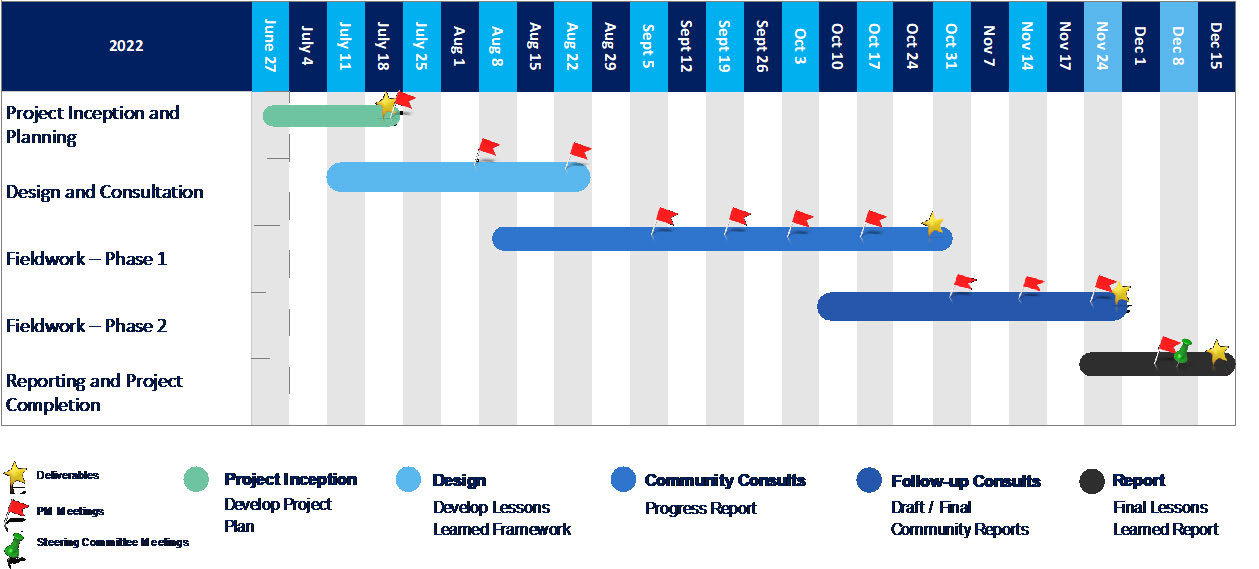
OFFICIAL
Document 1
Unfortunately, a dearth of local stakeholders with knowledge of each AACAP project meant that only
a few individuals were available to discuss site-related findings4. As such, the second rounds of
consultations / site visits were used to identify and interview additional stakeholders who may not
have been available during Round 1. Community Reports were then completed on the Basis of
information Provided during the two rounds of site visits.
REPORTING AND PROJECT COMPLETION
During this Stage, and throughout the Project, Keogh Bay produced a variety of reports and
presentations. All reports were developed my means of a desktop review and provided electronically
to the Project Steering Committee. Presentations and project updates were all delivered virtually via
videoconference. Deliverables included:
Project Plan (including a risk management plan)
Progress Report
Community Reports
Steering Committee Presentation
Final Report
The Gannt Chart below provides an overview of the timing of each phase, where meetings and
presentations were undertaken and the associated project deliverables.
Figure 3 - Project Management - Gannt Chart
Agency under FOI
Australians
Indigenous
4 Refer to the Findings and Recommendations Section of this report where caveats related to our findings are provided.
by the National
OFFICIAL
FOI/2425/086
Released
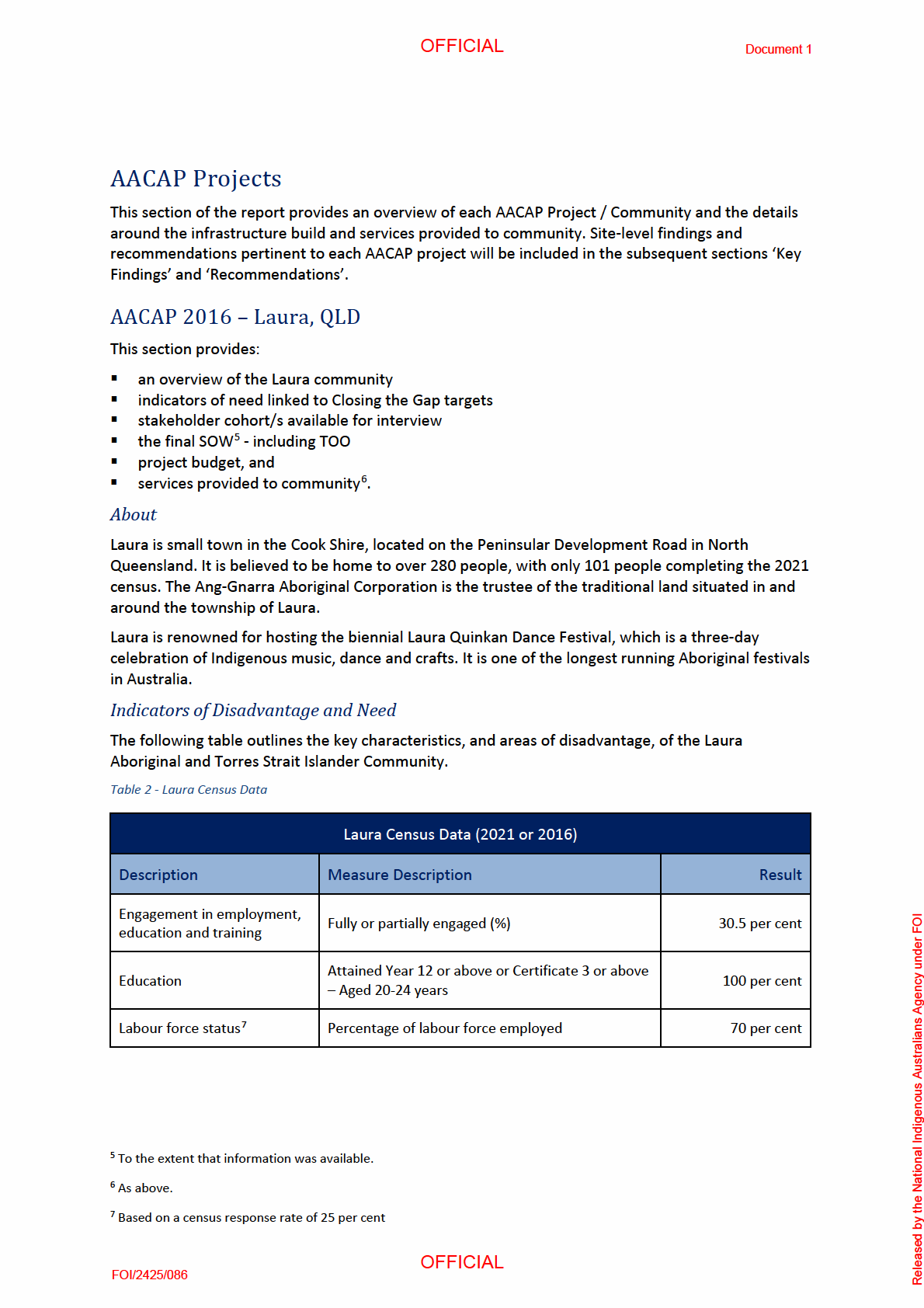
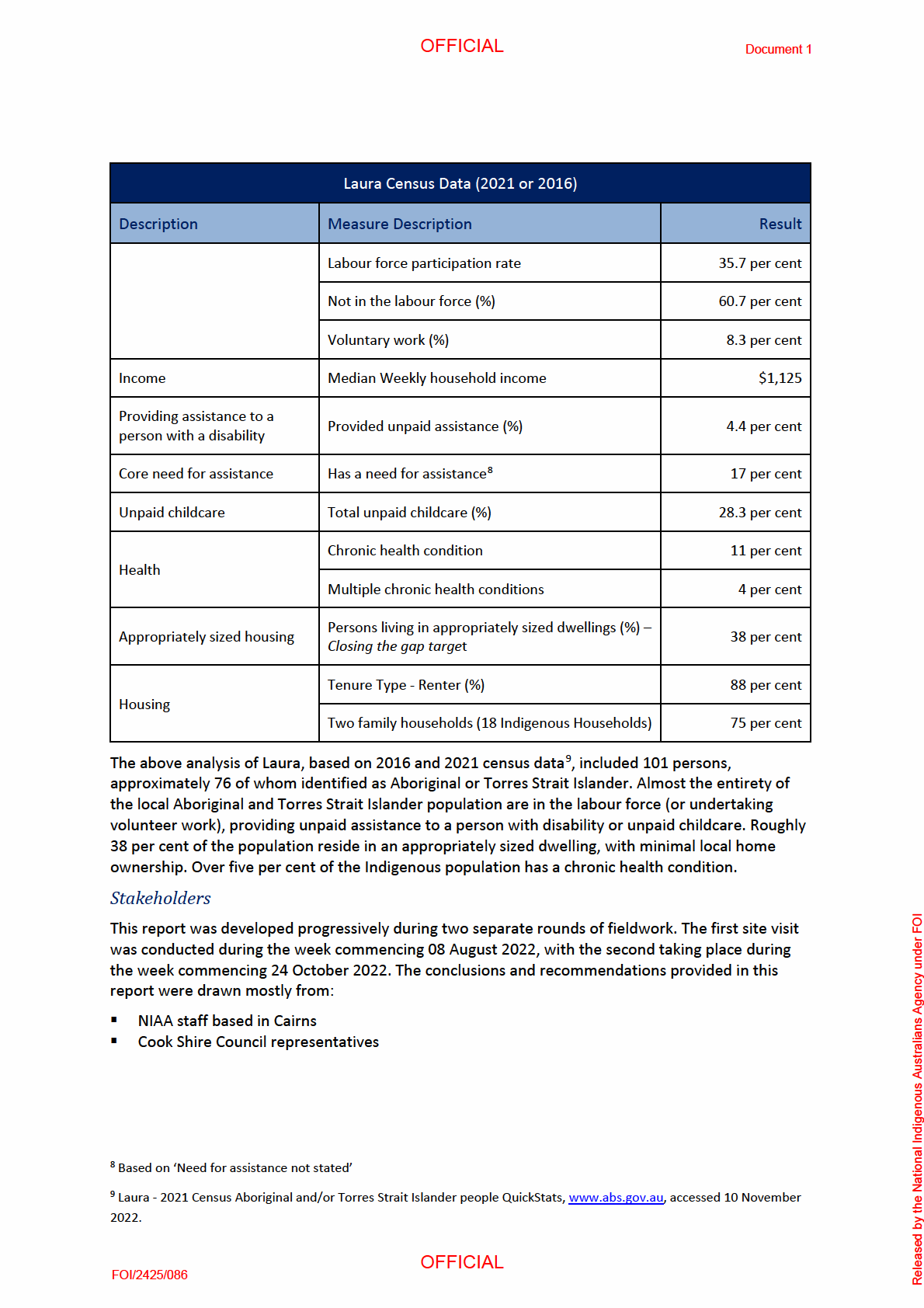
OFFICIAL
Document 1
Staff at the QLD Department of Seniors, Disability Services and Aboriginal and Torres Strait
Islander Partnerships (DSDSATSIP), and
Members of the Ang-Gnarra Aboriginal Corporation and its executives10.
Scope of Works and Budget
Based on the initial consultations undertaken, the SOW items agreed to by community
representatives were the following items:
Wastewater Treatment System (WTS) including a gravity sewer from properties throughout the
town to new treatment ponds and irrigation disposal.
Multi-Purpose Facility (MPF) consisting of office space, training space and a small kitchen facility.
Roof over the existing basketbal court.
Footpath along the Peninsula Developmental Road.
Some variations agreed to subsequently were, as fol ows:
Water Treatment System
→ The WTS was split into two components:
o Wastewater Disposal System
The system was designed to be capable of handling full waterborne sewage to facilitate
the possible future removal of household septic tanks (which were intended to remain
in the first instance).
o Wastewater Treatment Facility
A series of four treatment ponds and an irrigation pump house and irrigation area
(covering five hectares) were constructed to provide sufficient treatment to the
wastewater prior to disposal via irrigation.
Footpath
→ High pre-tender estimates of construction costs caused the length of the footpath scope item
to be reduced, which was later lengthened as budget constraints lessened.
Picnic Area
→ Not original y part of the scope, this item was added as a requirement of Indigenous Land
Use Agreement negotiations and included a covered area with picnic facilities and an open
fireplace.
Whilst onsite, Army delivered a smal number of Tasks of Opportunity, costing roughly $34,580.
These included:
an upgrade to the Pandanus Park War Veteran’s Retreat memorial
a picnic ground construction site (where trainees were offered the opportunity to work on a real
site), and a
a Health Centre outdoor area.
Overall, it was noted that AACAP 2016 came in at $660,000 under budget.
Agency under FOI
Australians
Indigenous
10 Refer to Appendix A for more details of stakeholders interviewed during Keogh Bay’s two rounds of community
consultations
by the National
OFFICIAL
FOI/2425/086
Released
OFFICIAL
Document 1
Service Provision
Training
As part of AACAP 2016, Army delivered a series of accredited and non-accredited training activities to
provide employability skil s and improve lifestyle in Laura and surrounds. Training activities
undertaken, were as follows:
Certificate II in Construction Pathways
→ Eight people participated in the course, with five completions. Four people obtained
employment as a result.
Certificate II in Hospitality (catering)
→ Six people participated in the course with four completions. Three people obtained
employment.
Non-accredited computer skil s, administration and media training to the Ang-Gnarra Aboriginal
Group, and
non-accredited photography and trade skil s training to the Laura Rangers.
Army’s training team also supported community engagement activities and NAIDOC Week
celebrations.
Employment
Several key employment opportunities were created as part of AACAP 2016, which included Cultural
Heritage Monitors and Pipe Laying Crews. This amounted to over 1,000 hours of employment.
Health
Health and ancillary Services provided to the community were as follows:
Medical
→ Army Medical and Nursing officers provided approximately 221 hours of community support,
which involved mostly community education around first aid, ear hygiene and healthy eating.
Dental
→ The Dental Team operated a clinic 6-days per week from May to September 2016 and
provided 780 hours of service to Laura and the surrounding communities.
→ The clinic provided services to 155 adults and 29 children.
Physical Training
→ Regular physical training assistance was provided to the Laura Primary School.
→ A physiotherapist assisted in community led playgroups on a weekly basis (in Laura and
surrounding communities) and provided education on identifying early signs of
developmental conditions in infants.
→ The rehabilitation team provided approximately 94 hours of assistance, which included the
support during the NAIDOC week rugby gala and a number of local sports competitions.
Veterinary
→ Army veterinarians provided roughly 100 hours’ worth of veterinary assistance, which
Agency under FOI
included 53 surgeries and examinations to the local pet population (mostly canines).
Australians
Indigenous
by the National
OFFICIAL
FOI/2425/086
Released
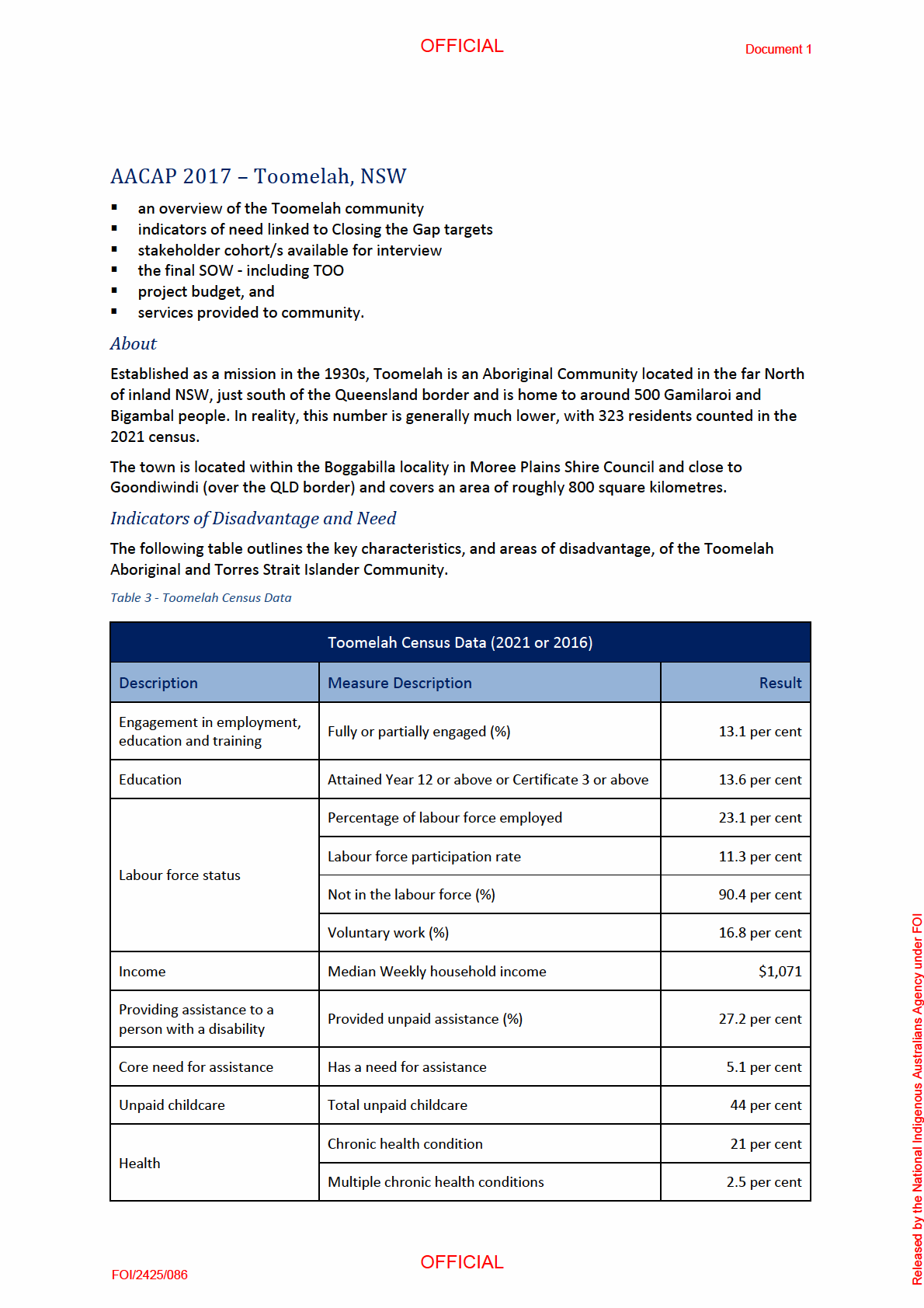
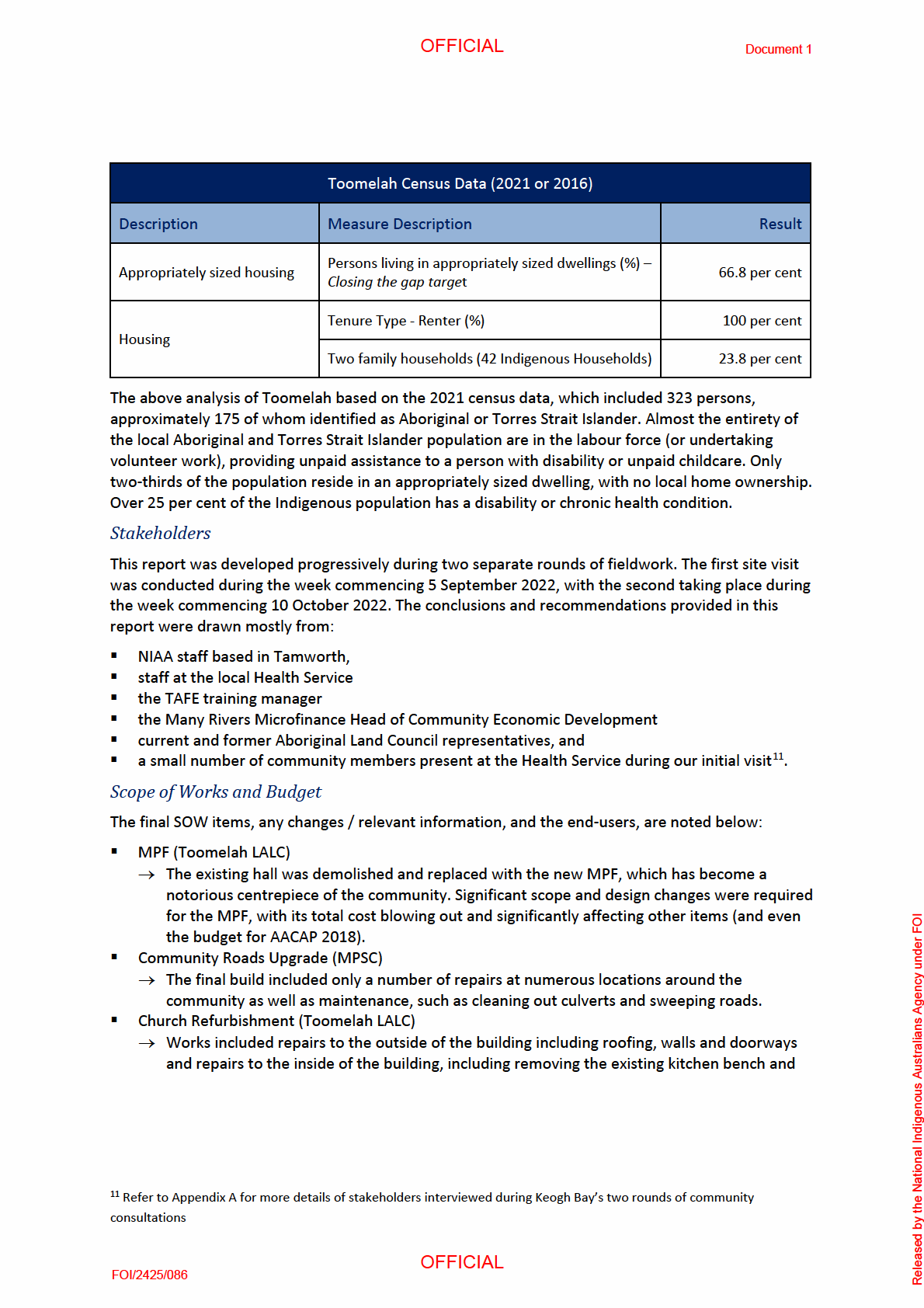
OFFICIAL
Document 1
sink, damaged sections of the internal wal s and floor and electrical upgrades. The interior
and exterior of the building was also painted.
Waste Management (Toomelah LALC)
→ Work was carried out as intended, with the asbestos from other demolition activities pushed
into the existing waste pits prior to remediation.
Oval Refurbishment (Toomelah LALC)
→ The final scope included minor improvements to the playing field and main building and the
instal ation of a new septic tank. Due to the lack of time and resources, major planned works
to the building were not undertaken. The oval playing surface, oval fence and seating were
omitted from the final scope.
Survey to Support Potential Subdivision (Toomelah LALC, NSWLALC, MPSC)
→ Army conducted a cadastral survey, which includes the lot boundary as well as the location
of internal roads and individual property boundaries / fence lines within Toomelah.
Initial y scoped Tasks of Opportunity included:
Playground fencing
War Memorial refurbishment
Canoe Tree area preservation and improvements
Kindergarten shade sail.
Given the scope issues impacting the MPF, it is unclear if there was budget left for TOO). The final
cost of AACAP 2017 was $7.3 mil ion against a budget of $6.7 mil ion and involved more that 34
variations over the course of the build.
Service Provision
Training Outcomes
As part of AACAP 2017, Army delivered a range of foundational employment and training activities,
health programs and veterinary treatments.
Training activities undertaken, were as follows:
Certificate II Construction Pathways / Certificate I Engineering (11 participants)
Certificate II Hospitality (21 participants)
Certificate II Business (9 participants – 3 completions)
Food Preparation (three trainees working in the Army Camp – Camp Birt – Kitchen)
First aid training (unknown participant numbers) – requirement for employment within many
industries
Employment Outcomes
Local community members were able to gain employment in the region as a result of training
provided by Army (e.g., at least two local people had taken jobs in hospitality in Goondiwindi after
gaining a Responsible Service of Alcohol certification. More than 25 people had completed this
course.
Agency under FOI
Health Outcomes
Health Services provided to the community were as follows:
Australians
A medical officer delivered 90 appointments at schools and clinics
A physiotherapist carried out 242 appointments
Indigenous
Various Dental procedures (e.g., cleaning, minor procedures and hygiene lessons) were
performed (193)
Education and training relating to the spread of disease in a communal environment
by the National
OFFICIAL
FOI/2425/086
Released
OFFICIAL
Document 1
The Army also led or took part in a range of physical training activities. These included:
A community Sports Program designed for members of the local community, the local rugby
team, the Toomelah school and a fitness session for women.
ADF personnel also led weekly running sessions in Goondiwindi.
Veterinary Treatment were delivered to local pets and rogue animals and involved:
Vet appointments (52)
Microchipping (22)
Other
Work Development Orders (WDOs)
→ WDOs are a NSW Government initiative to help people with unpaid fines to clear their debt.
NIAA facilitated an arrangement with NSW Legal Aid and the Army to have a range of WDO
activities that the community could sign up for (including the Army training).
→ The Army managed the administration and recording of participation, which resulted in more
than 40 fines being cleared. The total value for closed WDOs was almost $60,000.
TAFE
→ The TAFE campus at Boggabil a was reopened as part of the project and is stil open today.
Courses are increasing in variety and frequency, offering local people training relevant to
local opportunities (e.g., the Inland Rail workforce).
Capability Building and Mentoring
→ Toomelah LALC were provided with close support from Many Rivers Microfinance to help
understand the cost and chal enges of taking on ownership of the new assets.
AACAP 2018 – Yalata, SA
This section provides:
an overview of the Yalata community
indicators of need linked to Closing the Gap targets
stakeholder cohort/s available for interview
the final SOW - including TOO
project budget, and
services provided to community.
About
Yalata is an Aboriginal community located 200 kilometres west of Ceduna in the southwestern region
of South Australia. It covers an area of more than 4,500 square kilometres and lies on the traditional
lands of the Wirangu people. According to the 2021 census the community has a population of just
over 300.
Yalata was initially established as a sheep station (Yalata Station) in the late 1800s. In 1951, the South
Agency under FOI
Australian Government purchased the property for the benefit of Aboriginal people. It then became
a mission in 1954. In 1974 the Yalata Community Council took over the whole reserve, and the
mission ceased operations.
Australians
Yalata Land is held in trust under the Aboriginal Lands Trust Act 1966, under a 99-year Community
Residential Lease, and continues to be governed by the Yalata Community Council Incorporated.
Yalata Anangu Aboriginal Corporation was incorporated in 2015.
Indigenous
by the National
OFFICIAL
FOI/2425/086
Released
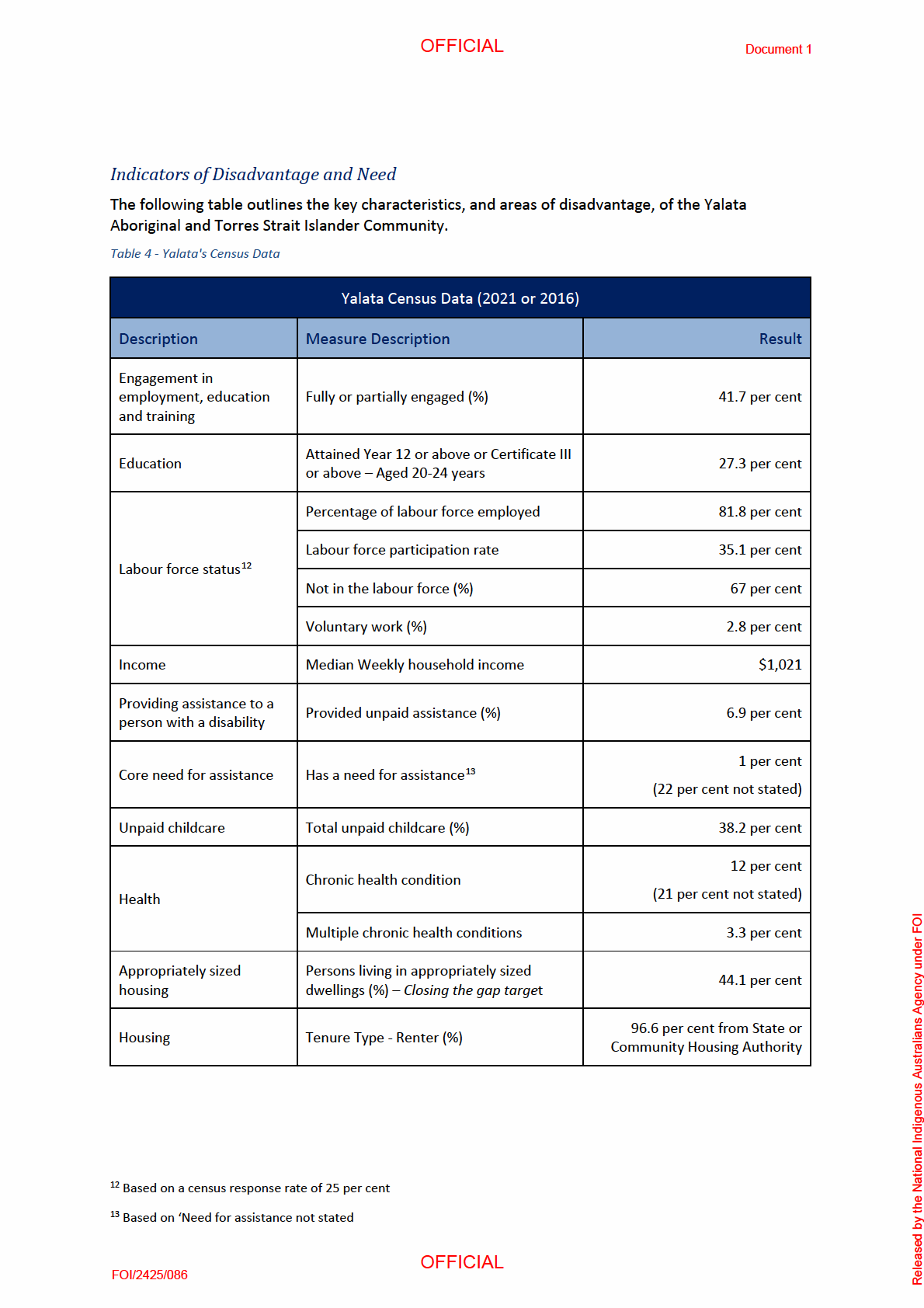
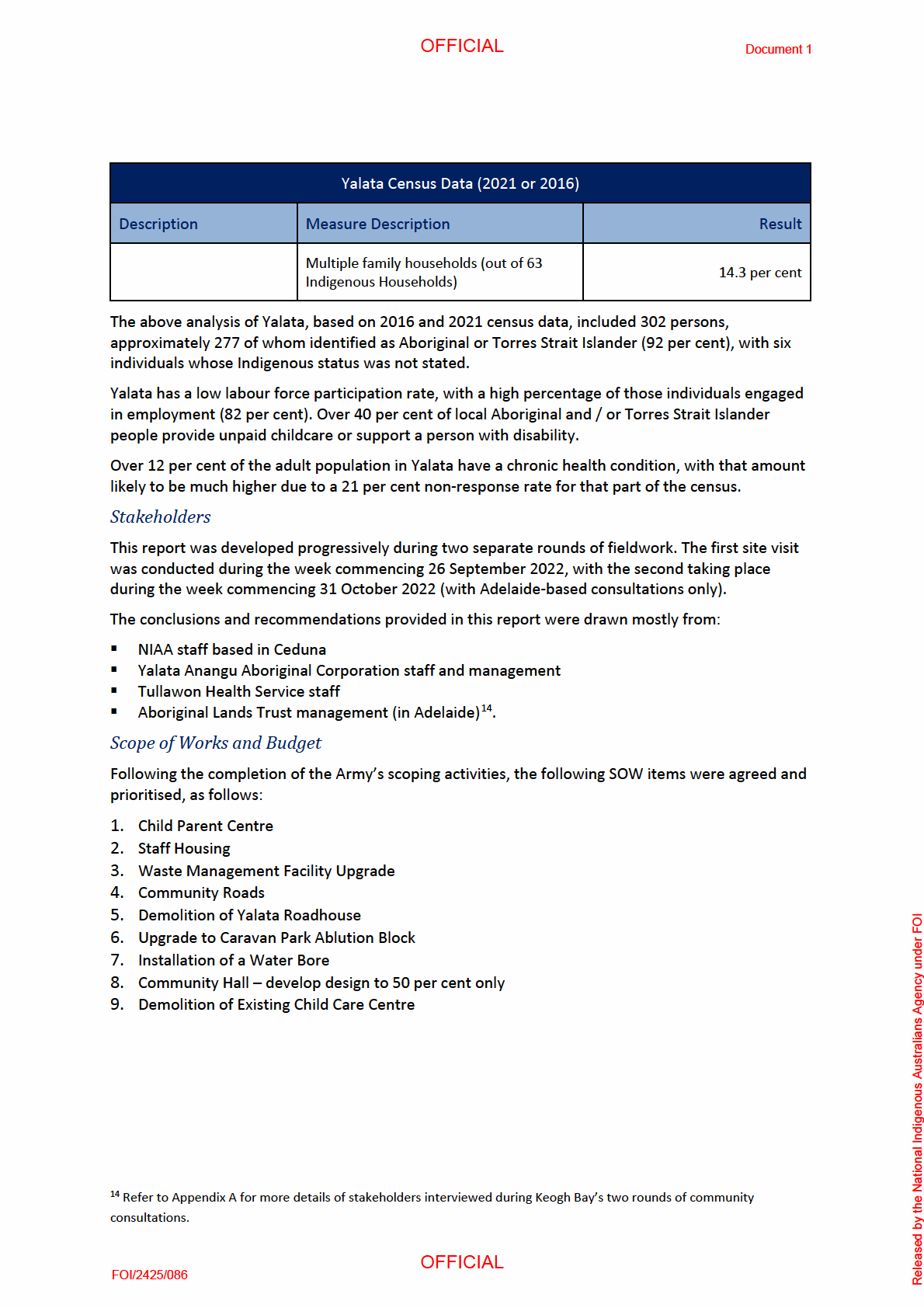
OFFICIAL
Document 1
Tasks of Opportunity that were separately identified, included:
an outdoor church upgrade, and
Caravan Park upgrades.
The total budget for the project was roughly $8.7 mil ion.
Service Provision
As part of AACAP 2018, Army provided foundation employability skil s and community engagement
training to members of the Yalata community. This included training in the areas of basic food
preparation, health awareness, first aid, construction and engineering, sports organisation and skil
development and business.
Training Outcomes
Training activities undertaken, were as follows:
Certificate II in Construction Pathways
→ Twenty-one people participated in the course, with only one completion.
Certificate I in Hospitality
→ Six people participated in the course with only two completions.
Photography Training – non-accredited training.
South Australian National Football League Clinic
→ This was a two-day clinic (including BBQ) that aimed to teach students all the basic skills of
Australian football as wel as encouraging a healthy, active lifestyle.
Employment Outcomes
Keogh Bay sighted no detailed employment outcomes relating to AACAP 2018.
Health Outcomes
Health and ancillary Services provided to the community were as follows:
Medical
→ Army’s Health Team provided support to the local health service (Tullawon Health Services),
which was intended to augment existing service delivery. Throughout the project over
$16,000 worth of support was provided, as follows:
o Medical– 174 patients over 221 hours
o Physiotherapy – 25 patients over 30 hours
Environmental Health
→ Army established a mentoring program to enhance the skil s of a local Aboriginal
Environmental Health Worker and developed and Environmental Health Notebook (and
supporting toolkit).
Dental
→ As above, the Army dental team augmented services provided by Tullawon. Throughout the
project over $36,000 worth of support was provided to 101 patients over 250 hours.
Agency under FOI
Health and Wellbeing
→ Army provided a range of presentations intended to improve general health and wellbeing to
community members. This consist of sports / PT, school briefs, and health and wellbeing
Australians
talks.
Veterinary
→ Army veterinarians provided roughly 39 hours’ worth of veterinary assistance at a cost of
Indigenous
roughly $12,000, which included 93 local vet patients.
by the National
OFFICIAL
FOI/2425/086
Released
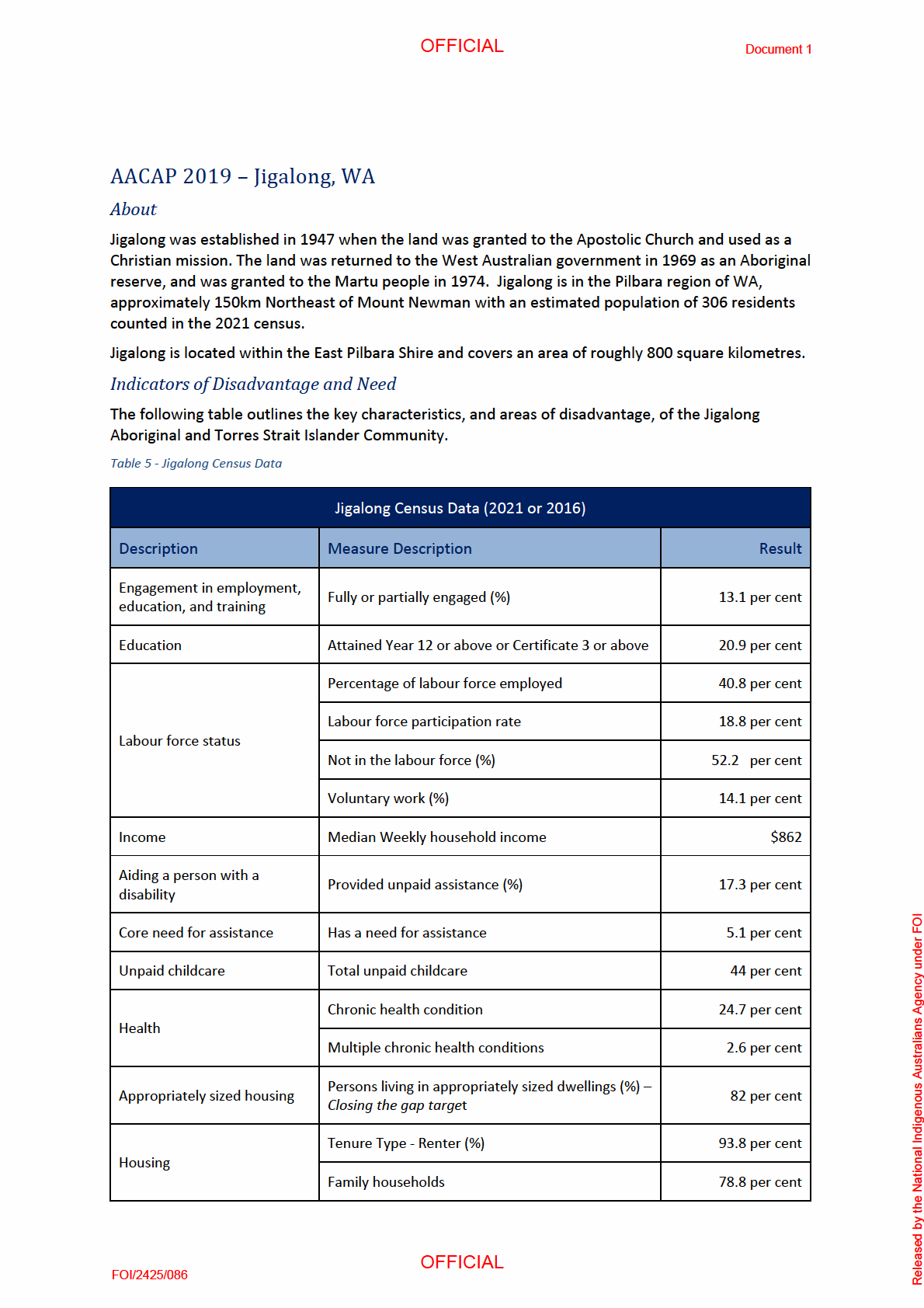
OFFICIAL
Document 1
The above analysis of Jigalong is based on the 2021 census data, which included 306 persons,
approximately 276 of whom identified as Aboriginal or Torres Strait Islander. Almost sixty percent of
the local Aboriginal and Torres Strait Islander population are in the labour force (or undertaking
volunteer work), providing unpaid assistance to a person with disability or unpaid childcare. Eighty
percent of the population reside in an appropriately sized dwelling, with no local home ownership.
Approximately 30 per cent of the Indigenous population is reported to have a disability or chronic
health condition.
Stakeholders
This report was developed progressively during two separate rounds of fieldwork. The conclusions
and recommendations provided in this report were drawn mostly from:
The current CEO and other staff at the community
NIAA staff based in South Hedland
staff at the community Health Service
a smal number of community members present during our visit
NGO services in Newman15
Scope of Works and Budget
As a result of the reconnaissance visits and scoping discussions / observations, the SOW items agreed
to by community, were as fol ows:
Creek Crossings
→ Construction of permanent Creek Crossings to improve access to the bores and rubbish tip to
al ow the community to fuel; the bore pumps and enable garbage removal from the
community.
BBQ Area
→ Communal area to enable three key areas:
o Facilitate large family gatherings
o External area for elders to convene
o Area for visitors to rest while in the community.
Amenities Block
→ Need for a public amenity to service male, female, and disabled users. Designed to separate
male and female users for cultural purposes.
Youth Centre
→ Requirement for a multi-purpose facility to engage youth and young families.
It does not appear that any TOO were developed, despite there being a budget allocation of more
than $50,000. The CEO indicated that he had attempted to facilitate the development of a new
garbage tip which was agreed to, but no action occurred.
Note: Fol owing completion of the build, it was later found that the creek crossing design was
inadequate for the location and weather extremes and was required to be rebuilt or refurbished
Agency under FOI
several times.
The total cost estimate for the project was $5.1 million.
Australians
Indigenous
15 Refer to Appendix A for more details of stakeholders interviewed during Keogh Bay’s two rounds of community
consultations.
by the National
OFFICIAL
FOI/2425/086
Released
OFFICIAL
Document 1
Service Provision
Health and Environmental Outcomes
Through AACAP 2019, Army delivered Environmental Health, Veterinary, Rehabilitation, Dental, and
Primary Health Care benefits to the Community. The Clinical Placement provided members of the
Army to augment the Jigalong Health Centre, thereby establishing a strong relationship with
members of community and health providers. The following services were delivered:
The Physiotherapist provided support for four days and saw a total of six patients.
The Primary Health Care team provided one medical officer for the first 10 days of rotation, and
then two for the remaining thirteen. A total of fifty-two patients were seen by the clinical staff.
First-aid training was provided. Which was aimed at community members seeking employment
in local industries and developing relevant skills.
Dental services delivered routine dental checks, minor procedures, and dental hygiene lessons.
Patients included:
→ 116 community patients
→ fifty-one military patients
The Environmental Health Team delivered education and training about the spread of disease in
a communal environment as well as conducting water testing, waste management and vector
control activities.
Various veterinary services were delivered over a two-week period, with a number of pets and
rogue animals treated. Veterinary treatments included:
→ Eighty dogs, one cat, one cow, one goat.
Physical training and sport through various exercise programs and sports events, including
softball, AFL, basketball with participation of ADF personnel and afternoon PT with school
students.
AACAP 2020 – Pormpuraaw, QLD
About
Pormpuraaw, located in the Cape York region approximately 500 kilometres from the tip of Australia,
covers an area of roughly 4,400 square kilometres, with a population of over 800 people. The area
original y was set up as the Edward River Mission in 1938, with Aboriginal people gradual y drawn
from their traditional lands into the mission settlement.
The Shire is a special Local Government Area (LGA) which is managed under a Deed of Grant in Trust
(DOGIT) under the Local Government (Community Government Areas) Act 2004. This was granted in
1986, enabling the Pormpuraaw Aboriginal Community Council to have ful local government
authority over the area.
Pormpuraaw is home to the Thaayore, Wik, Bakanh and Yir Yoront People. The Pormpuraaw
Aboriginal Shire Council (PASC), with the Cape York Land Council, controls and manages al the land
in Pormpuraaw.
Agency under FOI
Australians
Indigenous
by the National
OFFICIAL
FOI/2425/086
Released
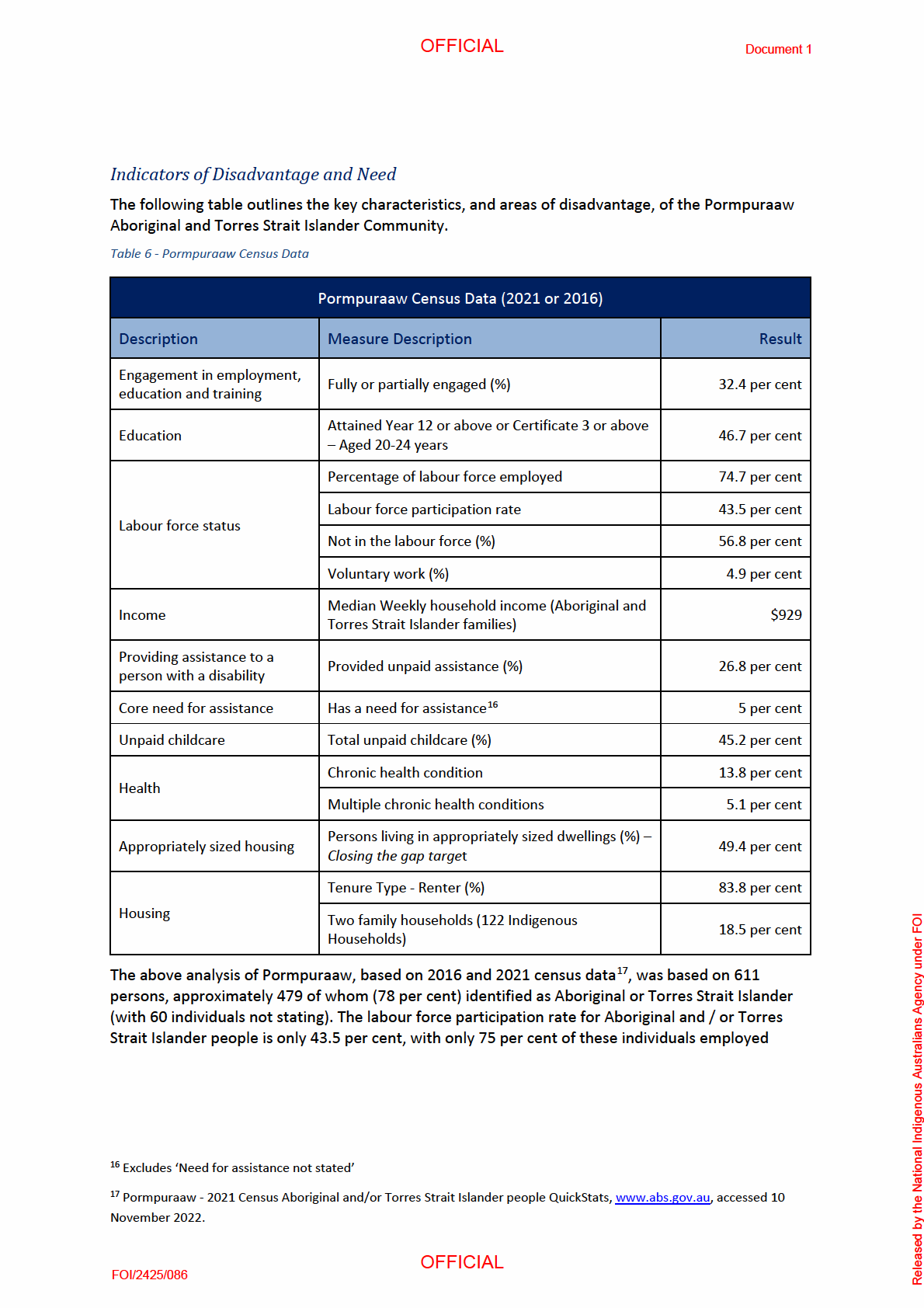
OFFICIAL
Document 1
(roughly 155 people). More than 25 per cent of the local population provides unpaid assistance to a
person with a disability.
Only half of the Aboriginal and Torres Strait Islander population live in an appropriately sized
dwelling, with minimal local home ownership (only nine homes that are owned outright). Roughly 60
per cent of housing is provided by a state housing authority. Over 13 per cent of the Indigenous
population has a chronic health condition.
Stakeholders
This report was developed progressively during two separate rounds of fieldwork. The first site visit
was conducted during the week commencing 08 August 2022, with the second taking place during
the week commencing 24 October 2022. The conclusions and recommendations provided in this
report were drawn mostly from:
NIAA staff based in Cairns
Cook Shire Council representatives
Staff at the QLD Department of Seniors, Disability Services and Aboriginal and Torres Strait
Islander Partnerships (DSDSATSIP)
Pormpuraaw Health Clinic Staff
Representatives from Pormpur Paanthu Aboriginal Corporation
Rise Ventures management18, and
members of the Pormpuraaw Aboriginal Shire Council and its Executives19.
Scope of Works and Budget
As a result of the reconnaissance visits and scoping discussions / observations, the SOW items agreed
to by community, were as fol ows:
Independent Living Facility
2 x 5 Lot subdivisions
Men’s Shed
The following items were discussed and removed from the Scope of Works:
Drainage works (planning support only)
Refurbishment of old DV Shelter Building
Caravan Park / Camping Area upgrade
Sports field irrigation
AACAP 2020 had a budget of $50,000 for TOO. The fol owing items were included for potential
development:
1 x 4 Lot Subdivision
Support to DSDSATSIP Town Centre Development
Agency under FOI
Australians
Indigenous
18 Training Provider
19 Refer to Appendix A for more details of stakeholders interviewed during Keogh Bay’s two rounds of community
consultations.
by the National
OFFICIAL
FOI/2425/086
Released
OFFICIAL
Document 1
It is understood that these were not developed. Whilst a closure report is not yet available, it is
believed that the following items were built opportunistically:
sports field benches
lighting, and
dog bowls.
Service Provision
It is understood that the fol owing services were provided to community.
Training
Army’s Scoping Overview did not identify exactly what training was to be included as part of AACAP
2020. They did, however, note the existence of Rise, who are the local training (CDP) provider.
In the absence of a closure report, it is not clear exactly what the training outcomes were. Keogh Bay
met with the training manager for Rise who noted that the fol owing training was provided to
interested community members:
Heavy Machinery
Maintenance and Construction
Hospitality
First Aid
Photography
Records of Certificate Completions or Employment outcomes were not available.
Employment
Whilst it was noted that some local people were engaged by Army in training as part of AACAP (e.g.,
in Maintenance and Construction), it is not clear how many local people secured employment
following the project.
Health and Wel being
Army’s AACAP 2020 Scoping Overview noted that they could strongly complement Pormpuraaw’s
existing Health and Dental services and that this would definitely be part of the Project.
Keogh Bay understands that these services were provided (as wel as veterinarian services) and that
they were well received and utilised. Without a Completion Report, we are unable to comment on
the nature, amount and cost of services provided, nor point to any specific outcomes.
Agency under FOI
Australians
Indigenous
by the National
OFFICIAL
FOI/2425/086
Released
OFFICIAL
Document 1
Key Findings
This section provides an overview of common themes and findings across al AACAP sites and
separately highlights specific themes relevant to each location / project.
Caveats / Limitations on Evidence
Whilst this engagement was focused on the five most recent AACAP projects, the impacts of COVID-
19 meant that some of these projects go back as far as 2015. In many instances, there are few people
from the relevant communities with knowledge of the project.
The views of many stakeholders have been informed by rumour and hearsay and often contradict
each other. The views and conclusions provided in this report and the community reports are subject
to inaccuracies and biases from such a smal sample size of individuals with knowledge of the project
(and those with the loudest voices). This is especial y problematic in communities where there is
long-standing conflict between family groups.
The conclusions and recommendations provided are drawn mostly from representatives from:
NIAA
State Government Agencies
Local Health Services
Training Providers
Aboriginal Land Councils / Shire Councils, and
a small number of community members available during our visits.
In addition to the above, Keogh Bay has had difficulty accessing documents or data relating to the
project, especial y information pertaining to any consultations that were conducted prior to or during
the project. As an example, this might include:
consultation notes with respect to how the community was selected and the basis on which the
determination was made. It is understood that these determinations were made between Army,
NIAA, other State based Government Agencies and Community Leaders (as outlined in this
report).
consultation notes regarding community need and expectations (i.e., between Army, NIAA and
local community leaders)
consultation notes kept by the project steering committee specific to that location (e.g., scope
and design changes, cost overruns and prioritisation of tasks of opportunity)
information included in End-User (or Asset-User) Agreements and how they were negotiated,
and
data regarding any due diligence that was done on the prospective future asset owners, including
negotiations on future commercial usage.
Common Themes and Findings
Agency under FOI
Listed below is a summary of the key findings that generally resonated across all sites. Comments can
generally be directly attributed to stakeholder views, which should be considered with a note of
caution given the caveats discussed above.
Australians
Comments provided under each of the key questions associated with the Lessons Learned Project.
These are provided in no particular order. Where applicable, information provided in the site-specific
fundings have been drawn upon to reach conclusions with respect to these areas of inquiry.
Indigenous
by the National
OFFICIAL
FOI/2425/086
Released
OFFICIAL
Document 1
ENGAGEMENTS AND PARTNERSHIPS WITH COMMUNITY
Based on Army Scoping Overviews and Completion Reports, it is clear that a long and staged build up
to each AACAP project is undertaken, which involves a fair degree of consultation with NIAA, State
Government Agencies, Service Providers, Community Leaders, School and Early Childcare
representatives. This is done in the form of reconnaissance visits, scoping visits, the development of
feasibility and scoping reports etc.
Many stakeholders on-the-ground in AACAP communities complained that community consultation:
did not occur early enough
was insufficient and only included a few community leaders
was not always reflective of the broader community needs, especially where family group
tensions existed within that community, and
could better scope out the nature of the health and training opportunities to be delivered in each
community (with close consideration given to Closing the Gap targets, where possible).
It was also observed that project working groups / steering committees did not include local
representation, with local people not involved with discussions or negotiations around large-scale
scope changes.
When reviewing Army reconnaissance documentation, the level of consultation appears to be more
extensive than that recal ed by local stakeholders. This would suggest that a broader degree of
project planning with community input (documented) needs to occur to al ay any future concerns.
In general, strong relationships appear to be the hallmark of a successful AACAP project. The
proactive involvement of State NIAA representatives was identified as a primary indicator of success.
Likewise, high levels of engagement from State Government agencies and local service providers
helped Army to better understand and scope the needs of community, and manage community
relationships and expectations.
INFRASTRUCTURE BUILD AND UPGRADE TO FACILITIES
Regardless of the community, each AACAP Project includes funding of $7 mil ion, which is matched
with an in-kind commitment of support from Army. It was clearly stated by virtually all stakeholders,
that they are grateful that their community was selected to receive the support and the asset/s that
came along with the project. Despite this, it was not always clear why their community was selected
and how the infrastructure plan evolved (and who signed off on it).
Refer to the AACAP Projects section above for the specific infrastructure that was developed. The
reports clearly highlight where infrastructure is fit-for-purpose and used by community and,
conversely, where assets were unused, not commercially viable or trouble by defects. Some notable
issues with infrastructure are as fol ows:
Laura – Stakeholders felt that the roof over the basketbal court was unnecessary and an
eyesore.
Agency under FOI
Pormpuraaw – The independent living facility sat unused as older people were not prepared to
leave their homes and risk losing it for their other family members. In addition, the Men’s Shed
sits unused as the Council has been unable to come to lease terms with a potential operator.
Toomelah – The new Multipurpose Facility had significant scope and design changes resulting in
Australians
a major cost blow out. This has resulted in increased maintenance and management costs and
the Land Council has been unable to commercialise the asset. It is also reportedly no longer
accessible by elderly people and not fit-for-purpose (i.e., it cannot host funerals as they are
Indigenous
unable to get coffins inside).
Jigalong – The creek crossing design was not suited to the location and weather extremes and
was required to be rebuilt or refurbished several times.
by the National
OFFICIAL
FOI/2425/086
Released
OFFICIAL
Document 1
As suggested above, many asset end-users did not appear to be sufficiently engaged prior to the
build to consider the implications of asset ownership (e.g., management and maintenance). Many
had not considered how the asset could be commercialised (e.g., possible service partners were not
able to pay rent).
The inclusion of Tasks of Opportunity as scope items helped to generate a degree of flexibility with
how Army approached and worked with Community. This enhanced the positive view of Army in
Community. Smal things such as the construction of benches, dog bowls and community signage
were delivered and were often recalled fondly by members of the community. Given cost blow-outs
and scope changes affecting many communities, the scope of TOO items was often reduced.
With the exception of one Community (Pormpuraaw), it was clear that end-users were happy with
Army’s responsiveness to any defects encountered, the flexibility they’ve shown with respect to the
defect liability period and the overall quality of work.
IMPACT OF ARMY PERSONNEL BEING IN COMMUNITY
There was virtually unanimous praise for Army personnel and their relationships with community
(especially the youth). Army personnel were held in high regard, often doing small things like carrying
people’s groceries to their cars. Army personnel were active in community, participating in (or
leading) a range of activities, such as:
welcome ceremonies
NAIDOC events
cultural festivities
AACAP kick off and closing ceremonies
community BBQs
tours of Camp Birt
workplace support for local trainees (e.g., hospitality students working at Camp Birt)
rugby or AFL tournaments, and
community health and wellbeing events (including personal training).
Where Army had located there camp close to community there was a higher level of engagement
from the community. In Yalata, it was notable that Army camped quite a long way from community
and delivered most of its part of the infrastructure build outside of community, utilising sub-
contractors to do work in town. This resulted in lesser degrees of engagement and satisfaction. This
was the exception of the five communities assessed.
As a result of Army’s high engagement with community, there was reported to be a notable
improvement in school attendance rates in some of the communities. In addition, community
members were actively attending physical training activities and health education sessions, leading
to an increased awareness of general health and wellbeing (see below).
The only negative, which was reported across a number of locations, was that each community and
community members (especial y young people) received what was described as a ‘sugar hit’ when
army are in community, leaving notable lull post-completion. Army could address this by leaving staff
Agency under FOI
on location during the defect liability period and engaging a cultural liaison officer.
OUTCOMES OF TRAINING AND DEVELOPMENT ACTIVITIES
Australians
As documented throughout this report, Army provided a range of certified and non-certified training
to local people with some successful completions and a few employment opportunities identified.
There are opportunities for improvement here also, where training could be broader (i.e., beyond
Indigenous
the needs of the project). It was suggested that there was an opportunity to target more training to
women.
by the National
OFFICIAL
FOI/2425/086
Released
OFFICIAL
Document 1
In general, there appeared to be better outcomes when community leaders (and members of the
community) were more ful y consulted during the reconnaissance and scoping phases of each
project.
Key findings with respect to the outcomes of training and development activities varied from
community to community. Refer to the site-specific outcomes highlighted in the AACAP Project
Summaries in the preceding section of this report.
As an example, in Toomelah (AACAP 2017), the following training outcomes were achieved:
Certificate II Construction Pathways / Certificate I Engineering (11 participants)
Certificate II Hospitality (21 participants)
Certificate II Business (9 participants – 3 completions)
Food Preparation (three trainees working in the Army Camp – Camp Birt – Kitchen)
HEALTHCARE AND OTHER AUXILIARY HEALTH OUTCOMES IN THE COMMUNITY
As part of each AACAP Project, Army provide a range of health, allied health and dental services. This
is generally supplemented with health promotion projects (e.g., fitness sessions) and Veterinarian
Services.
The delivery of these health and dental services, designed to augment existing services, were greatly
appreciated by community members, with high levels of uptake. In addition, local health workers
appreciated the presence of Army in that there was a degree of skill sharing between the two groups
(e.g., Army staff learned how work in and engage with Aboriginal communities and local health
workers could participate in training provided by specialists, where available).
As with the training and development activities above, there appeared to be better outcomes when
community leaders (and members of the community) were more ful y consulted during the
reconnaissance and scoping phases of each project. With respect to these services, there was a
feeling that more could be done (e.g., targeting older men who can be reluctant to seek help).
Once again, the Health Outcomes are outlined in the site-specific outcomes highlighted in the AACAP
Project Summaries in the preceding section of this report. Using Toomelah and an example, the
following Health, wellbeing and veterinary services were provided to community:
A medical officer delivered 90 appointments at schools and clinics
A physiotherapist carried out 242 appointments
Various Dental procedures (e.g., cleaning, minor procedures and hygiene lessons) were
performed (193)
Education and training relating to the spread of disease in a communal environment
The Army also led or took part in a range of physical training activities. These included:
A community Sports Program designed for members of the local community, the local rugby
team, the Toomelah school and a fitness session for women.
ADF personnel also led weekly running sessions in Goondiwindi.
Agency under FOI
Veterinary Treatment were delivered to local pets and rogue animals and involved:
Vet appointments (52)
Australians
Microchipping (22)
EMPLOYMENT OUTCOMES
Indigenous
Employment outcomes were generally not well documented in project completion reports. There
was some anecdotal evidence provided that the most common employment outcome was in the
hospitality sector, where individuals had completed their Responsible Service of Alcohol Certificates
by the National
OFFICIAL
FOI/2425/086
Released
OFFICIAL
Document 1
and other training provided by the Army (e.g., Certificate II in Hospitality). In some instances, Army
was able to mentor trainees in their camp kitchens.
Other potential employment opportunities were linked to Maintenance and Construction, where
local people were engaged in the build. This was rare.
As noted above, in Toomelah, local residents are now accessing training from TAFE that is directly
related to employment opportunities (e.g., the Inland Rail Workforce).
In Laura, it was noted that over 1,000 hours of employment was created. This included local people
being employed as Cultural Heritage monitors and pipe laying crews.
For more detail, refer to the site-specific reports.
POST-PROGRAM BENEFITS
Across-the-board, there were few notable and consistent residual program benefits reported. This
varied greatly between sites. As described throughout the report, many infrastructure items sit
unused or are not fit for purpose, while others are greatly appreciated.
In the case of Toomelah, the local TAFE campus reopened to provide training and remains open to
this day, capitalising on relevant local training opportunities. In addition, community members were
able to complete Work Development Orders as part of Army’s training in order to pay off
accumulated fines. In total, 40 fines were clear, worth almost $60,000.
As noted earlier in this report, the nature of Closing the Gaps targets, or other measures of
disadvantage impacting Aboriginal and Torres Strait Islander people are generational in nature. The
impacts of a single AACAP project is unlikely to make dramatic and sustainable change (especial y
given the short timeframes involved).
We note, however, the focus on training and education, as well as the delivery of augmenting health,
wellbeing, dental and other services are targeted to community needs and do align with Closing the
gap Targets. Accordingly, there wil be a benefit to community linked to these targets and indicators
of disadvantage.
As recommended in the next section of the report, a full evaluation of each AACAP project within 12
months of project completion would help to establish any long-term benefits or determine how the
program can be changed to improve long-term benefits. These learnings can then be applied to
future AACAP Projects.
ADDITIONAL SUPPORT REQUIRED TO HELP COMMUNITIES FULLY LEVERAGE ALL THE BENEFITS OF AACAP
As noted earlier, it was felt that Army personnel could stay in community longer (e.g., undertake a
staged withdrawal from community) and continue to run programs and activities during the defect
liability period for each project.
Agency under FOI
It was also recommended that asset-owners be provided with up to 12-months of post program
support to help understand the cost and challenges of taking on new assets and to develop a
sustainable commercial model. Many Rivers Microfinance has worked in a couple of communities to
Australians
provide post-project support. This would be in addition to support provided during the build. Where
required, proper support wil help to understand al the nuances around asset ownership,
management, maintenance, replacement and commercialisation.
Indigenous
As above, a post-project completion review will help to further determine any additional support
required by community and asset owners to leverage al the benefits from AACAP.
by the National
OFFICIAL
FOI/2425/086
Released
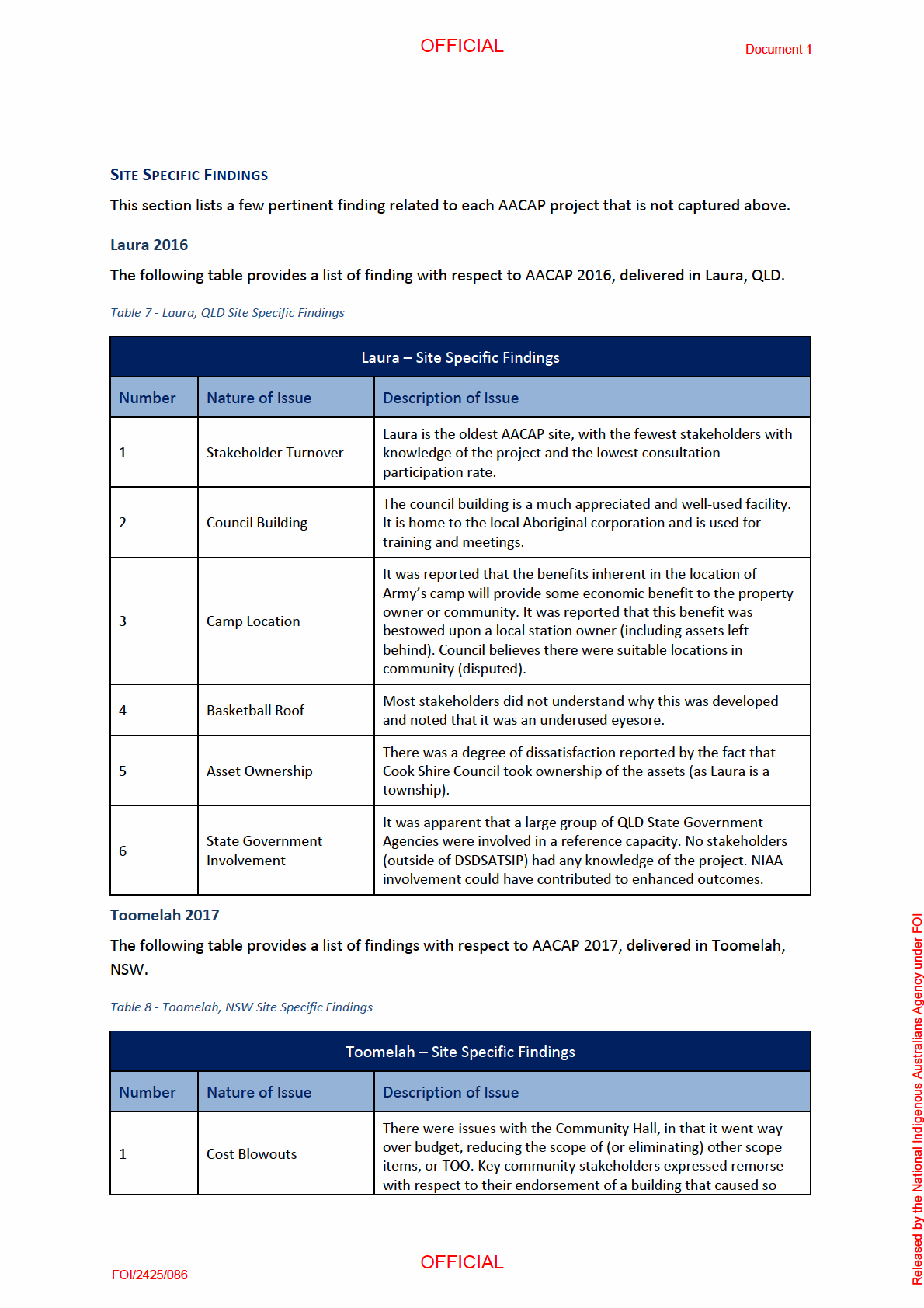
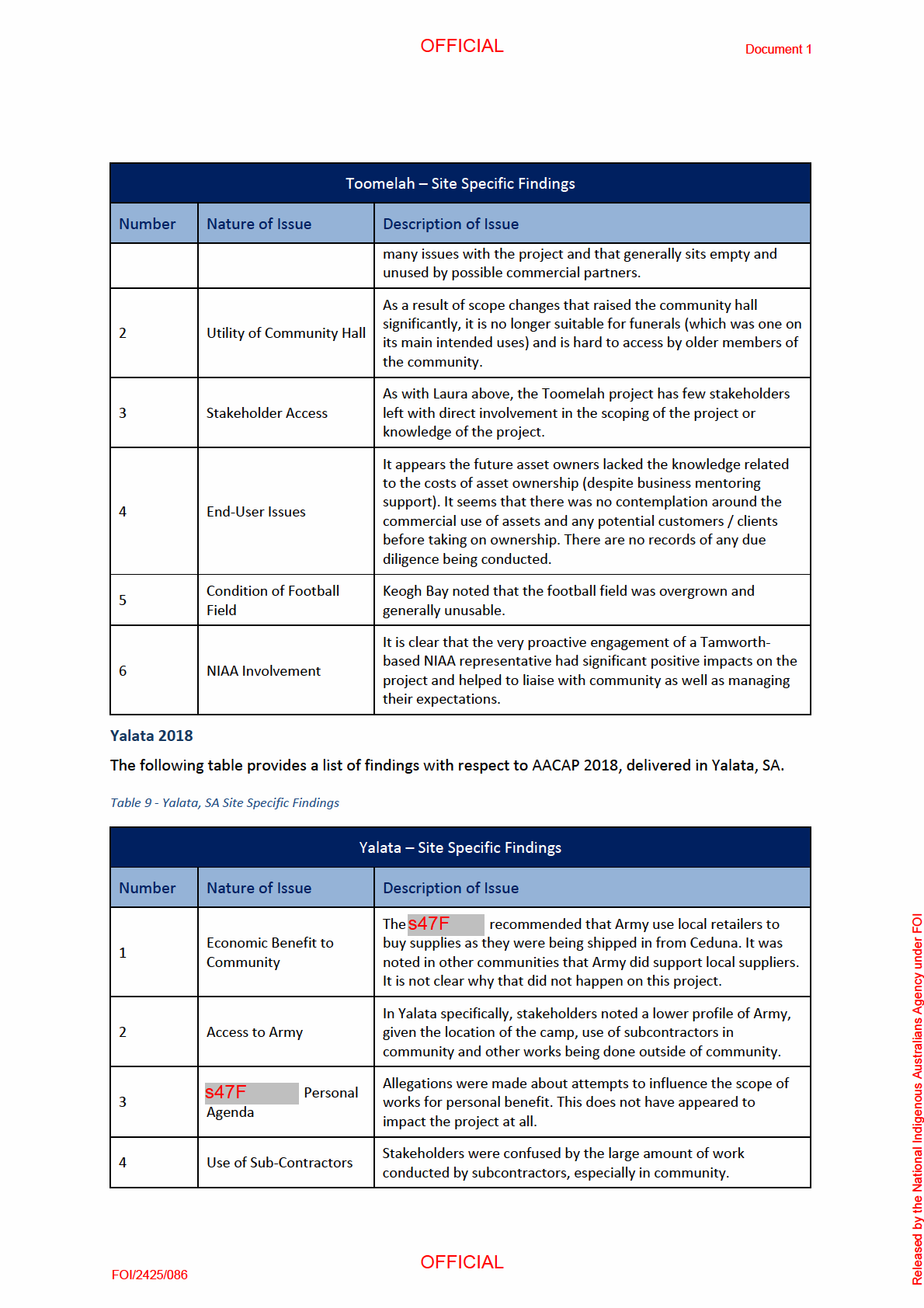
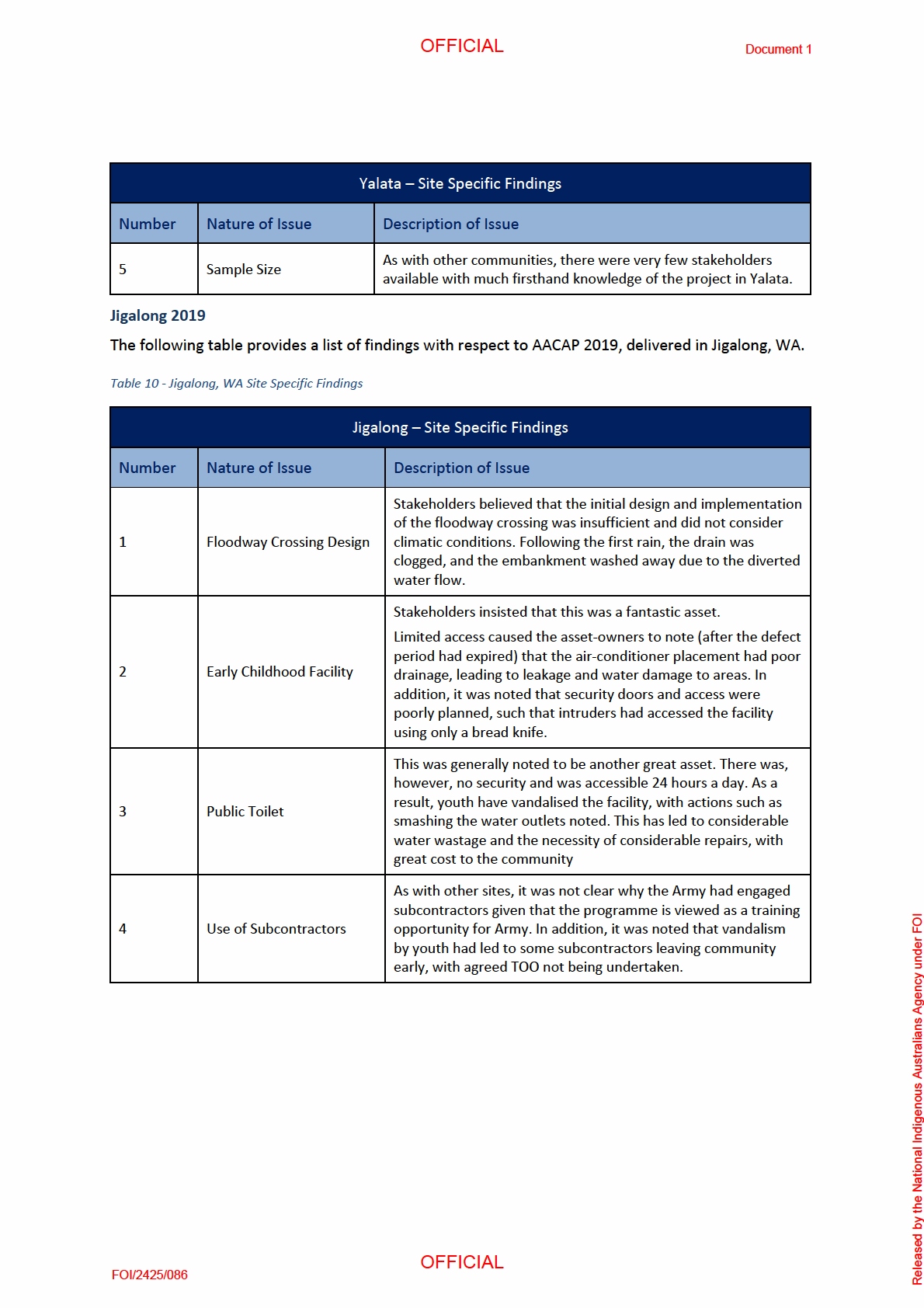
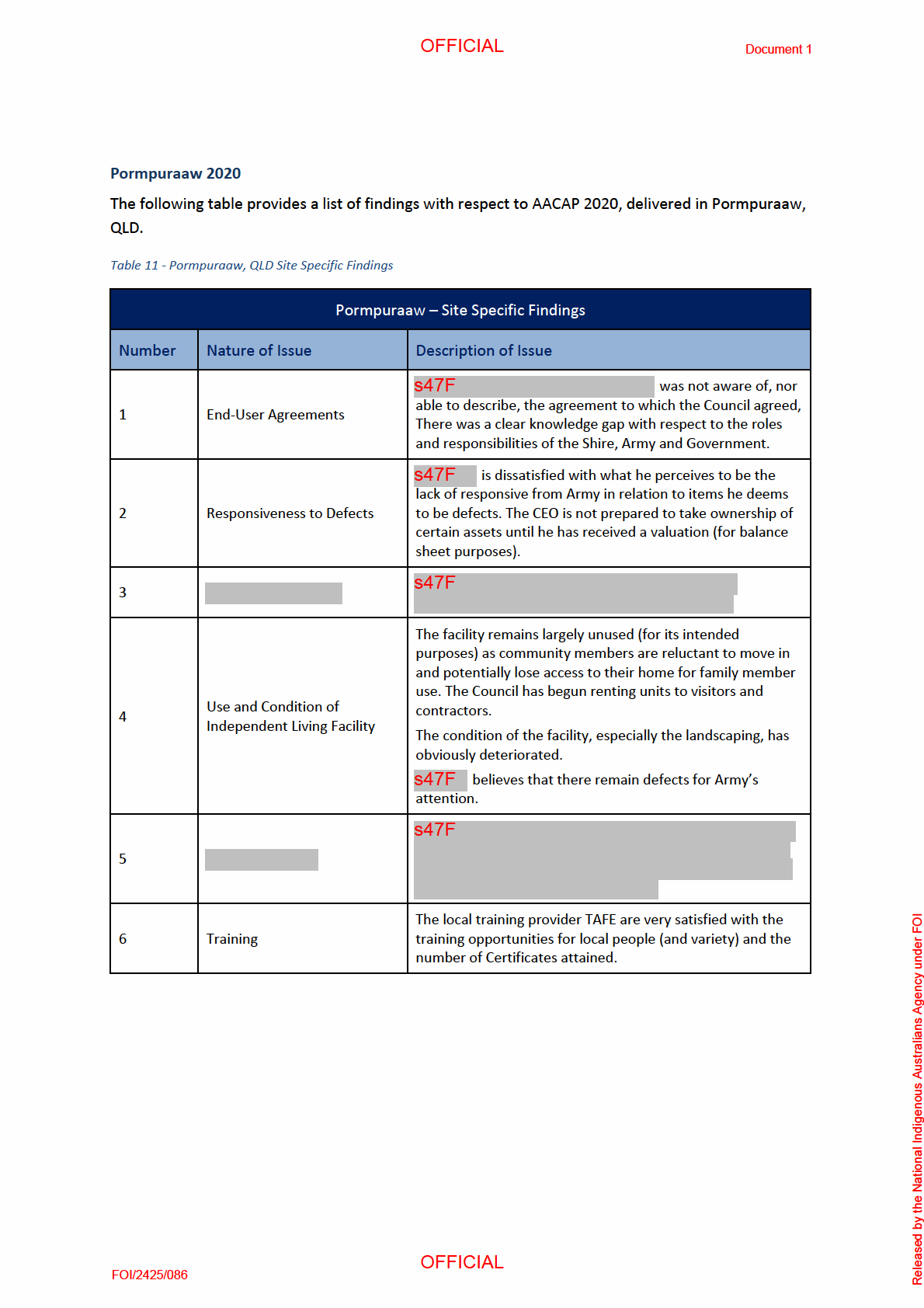
OFFICIAL
Document 1
Recommendations
This section provides an overview of recommendations common to al AACAP sites, including
recommendations for ongoing support and ways to assess and preserve program benefits post
completion. We have also separately highlighted recommendations specific to each location /
project. Findings are presented sequentially (i.e., the order in which the AACAP program is scoped
and delivered). Given the paucity of available information and the dominance of a few stakeholders,
recommendations have not been presented in any priority or order of importance.
Recommendations common across all sites
Consultation / Record Keeping
→ In recognition of the high turnover of project staff (in Army and al other agencies), it was
strongly recommended that there be more fulsome reporting of consultative activities and a
document trail to ensure there is clarity around al aspects of the project that can explain
how the SOW items were agreed and how scope changes were managed throughout the
project.
→ It would also be useful to keep records for review with respect to how the training and
services provided to local people were designed, in order to promote their health and
wellbeing.
→ Whilst the level of consultation undertaken appears to be expansive (as noted in the
preceding section), the fol owing was often reported by local community members or
representatives:
o There has been disappointment expressed with the overal communication throughout
the project, with reports that it can be piecemeal and inconsistent.
o Council members and community members were often unsure about with whom in
Army they should communicate (noting that there is high turnover of Army personnel,
even during AACAP projects). For example, in Yalata, there were changes in the
Community Liaison role that were not communicated to community.
o Community members can find ‘Army Speak’ to be a major barrier to communication. In
order to improve understanding and build genuine engagement, the language needs to
be appropriate for the audience.
o Any consultations undertaken should include a broader swathe of local stakeholders,
including representation from various family groups, especially where there is known
conflict within community (e.g., Pormpuraaw).
o Project working groups / steering committees should also involve a representative group
of community members and service providers.
Demand on community
Agency under FOI
→ Views have been provided that the AACAP project can place a significant demand on top of
the already demanding workload facing community members, leaders and local councils. This
can make the community feel overwhelmed, particularly by the amount of emails and
Australians
meetings from Army. When contemplating the timing of consultations and the build,
engagement from Army and the Steering Committee could focus on existing community
Indigenous
demands and availability.
by the National
OFFICIAL
FOI/2425/086
Released
OFFICIAL
Document 1
Issues with Army entering and leaving community
→ Another universal comment made by stakeholders interviewed at each site was the intensity
of the ‘sugar hit’ of Army being in community, fol owed by the inevitable ‘lul ’ and local
malaise when Army completes the build and rapidly redeploys.
→ A solution was offered, wherein a smal contingent of Army personnel (including the Training
Development Officer) arrive ahead of the build to further review the SOW items and, more
importantly, the education, training, health and employment needs of the community.
Further, that a smal contingent of Army Personnel remain in the community for at least 6-
month post-build to manage some of the defect issues and engage with community.
End-User (or Asset-User) issues
→ It is unclear as to the level of due diligence / negotiation that was done with the entities that
were to take on ownership of the new assets. It was obvious in some communities that the
recurrent expenses associated with managing the new assets was going to be a problem. In
support of this point, it was obvious some communities that the assets were not being well
maintained. For example, the Independent Living Facility in Pormpuraaw and the Sports Oval
in Toomelah.
→ Some stakeholders noted that it may be necessary to engage a third party to help End-Users
understand the implications of the agreement into which they are entering.
Asset maintenance and cost of ownership / upkeep
→ As above, there are clear instances where the asset-owners are struggling with the costs of
asset management (e.g., the MPF in Toomelah). This has had the impact of asset-owners
attempting to monetise the infrastructure, resulting in community conflict, lack of use and
deterioration of the asset. This is also reflective of the viewpoint that the community was not
consulted on the assets that were most suited to them and that potential asset-owners had
not ful y understood or considered the future implications of taking on asset ownership.
→ Earlier engagement with potential asset-owners should take place to ensure that al aspects
of asset ownership and commercialisation are understood.
Use of Subcontractors
→ In some communities there was confusion as to why the Army had engaged sub-contractors
to build substantial pieces of infrastructure. It was questioned why a project designed to help
train personnel had been outsourced. This could be managed by broader community
engagement and consultation, especial y for the duration of the build.
Involvement of local people and organisations
→ There was some question from local community members as to why Army and their
subcontractors couldn’t do more to offer employment opportunities to local people or use
local organisations as sub-contractors (where it is practical to do so). Army should investigate
Agency under FOI
the possibility of engaging local people in the build where it is practical to do so (including
the use of local organisations as subcontractors).
Australians
→ Likewise, it was reinforced, that where possible, Army utilise local suppliers and retailers to
support their operations during the build (e.g., the local community store or local owned
hardware store).
Indigenous
Infrastructure
→ In a smal number of instances, there was some confusion and dissatisfaction with respect to
the choice of infrastructure that was proposed and built. This was compounded by the
by the National
OFFICIAL
FOI/2425/086
Released
